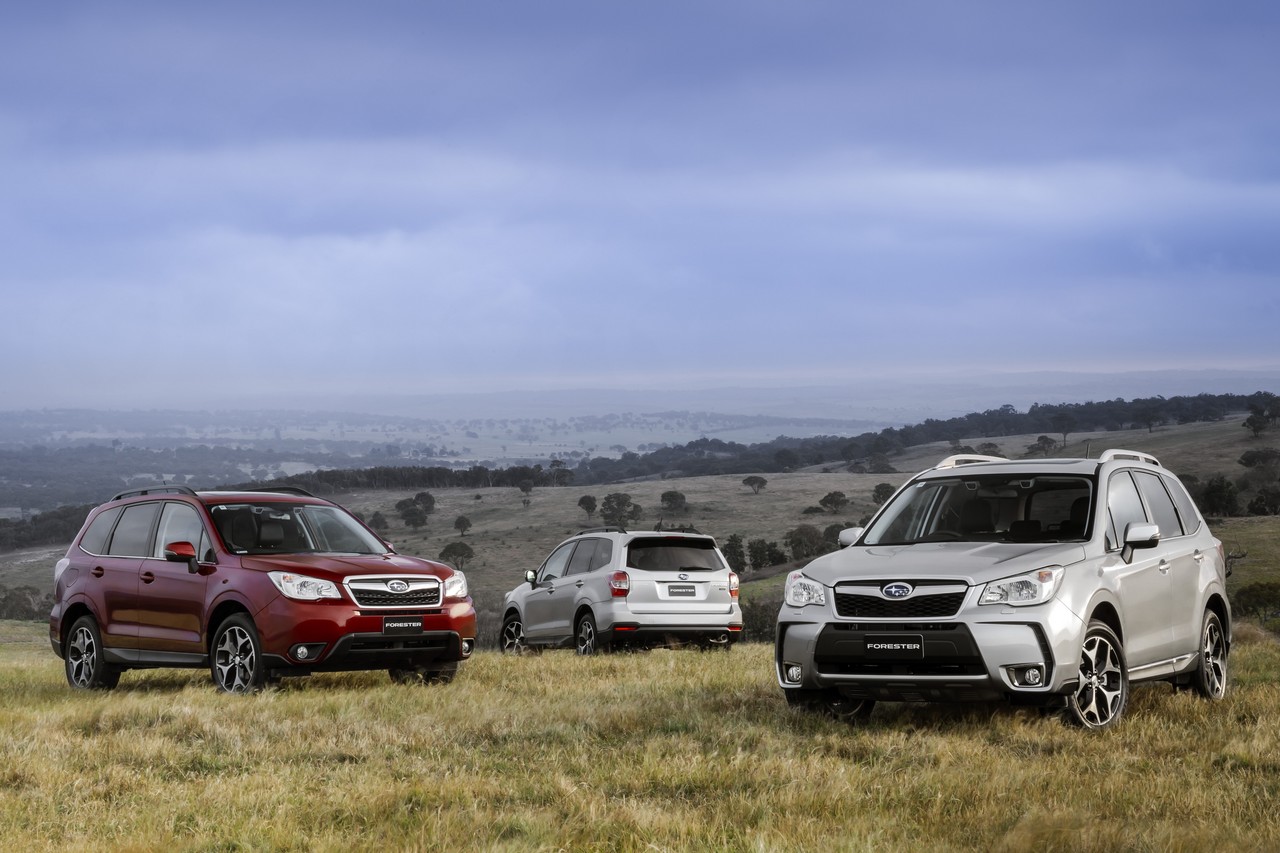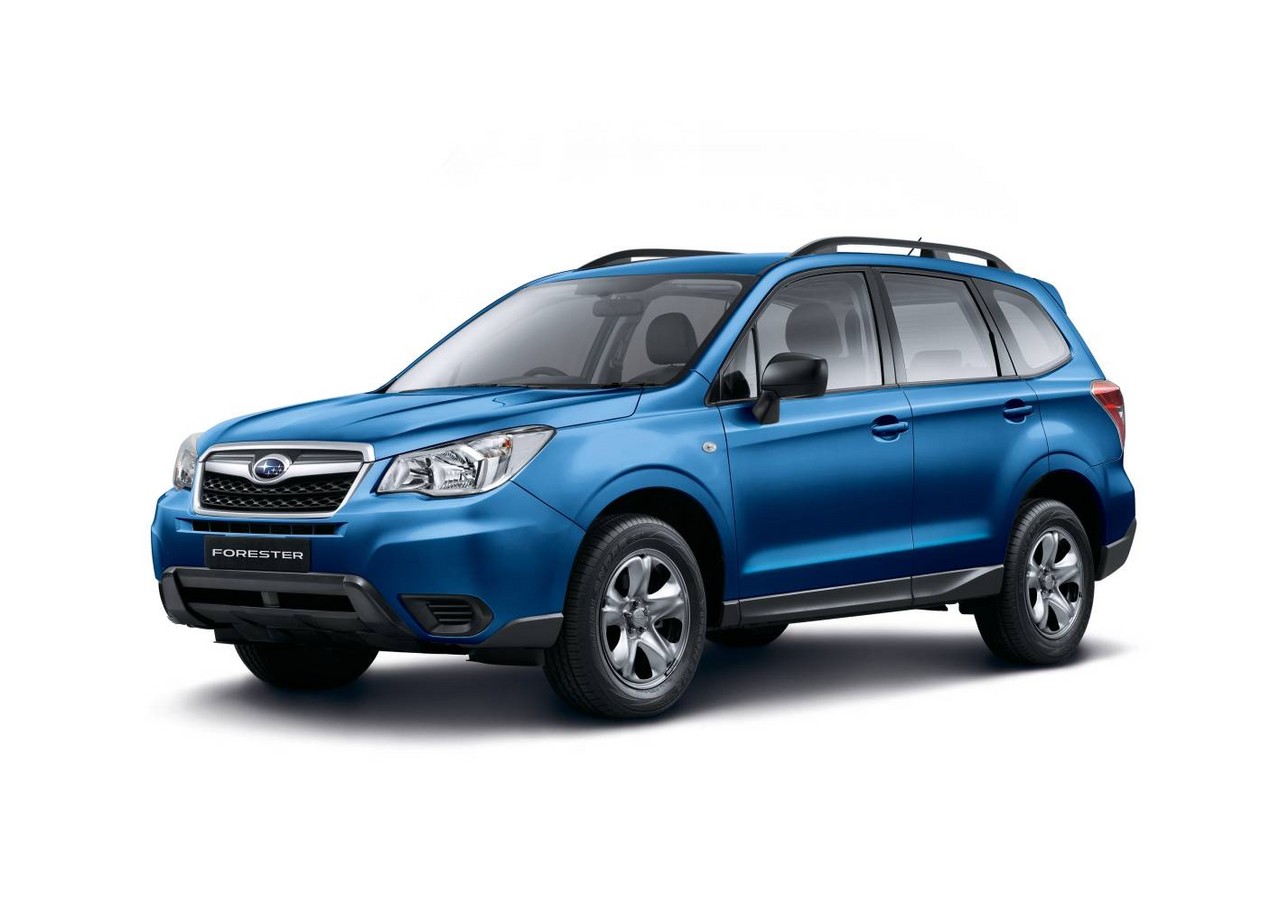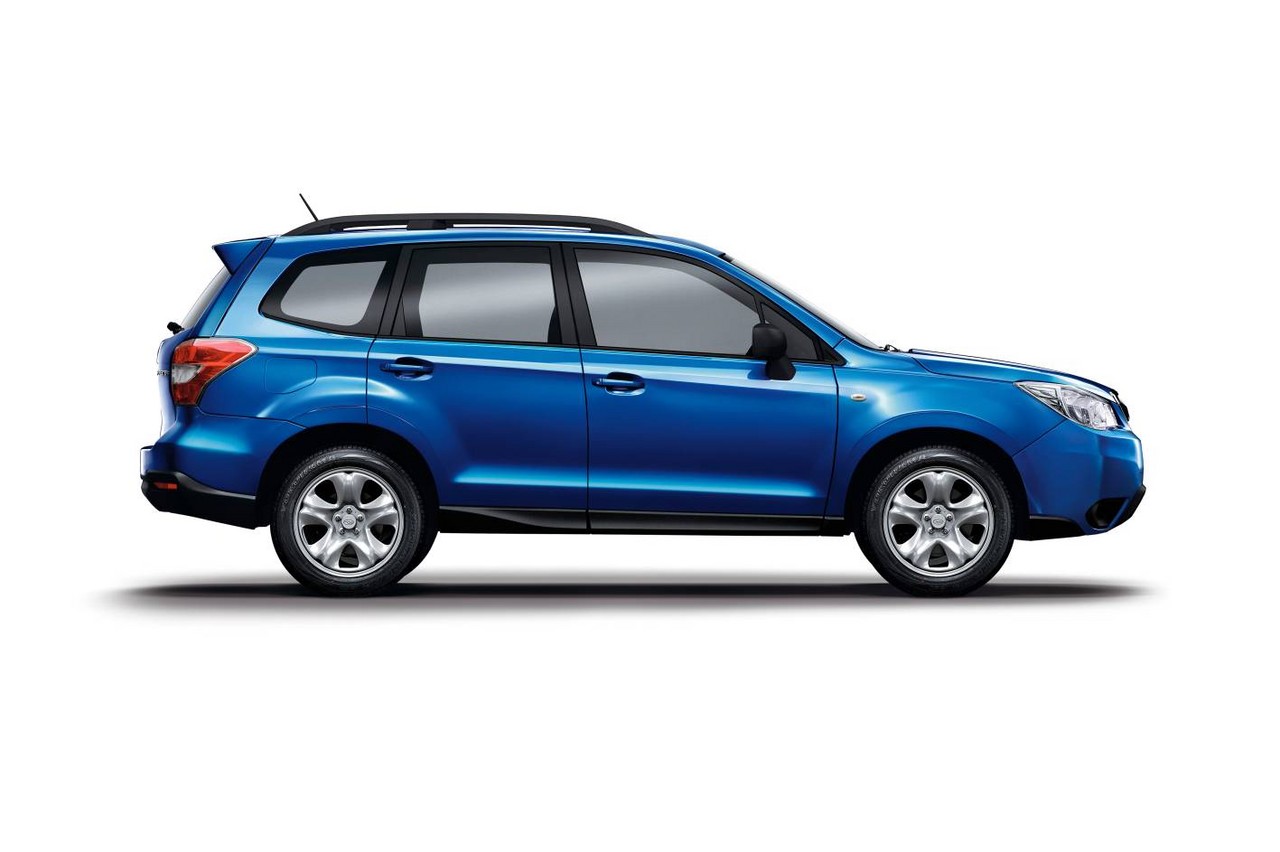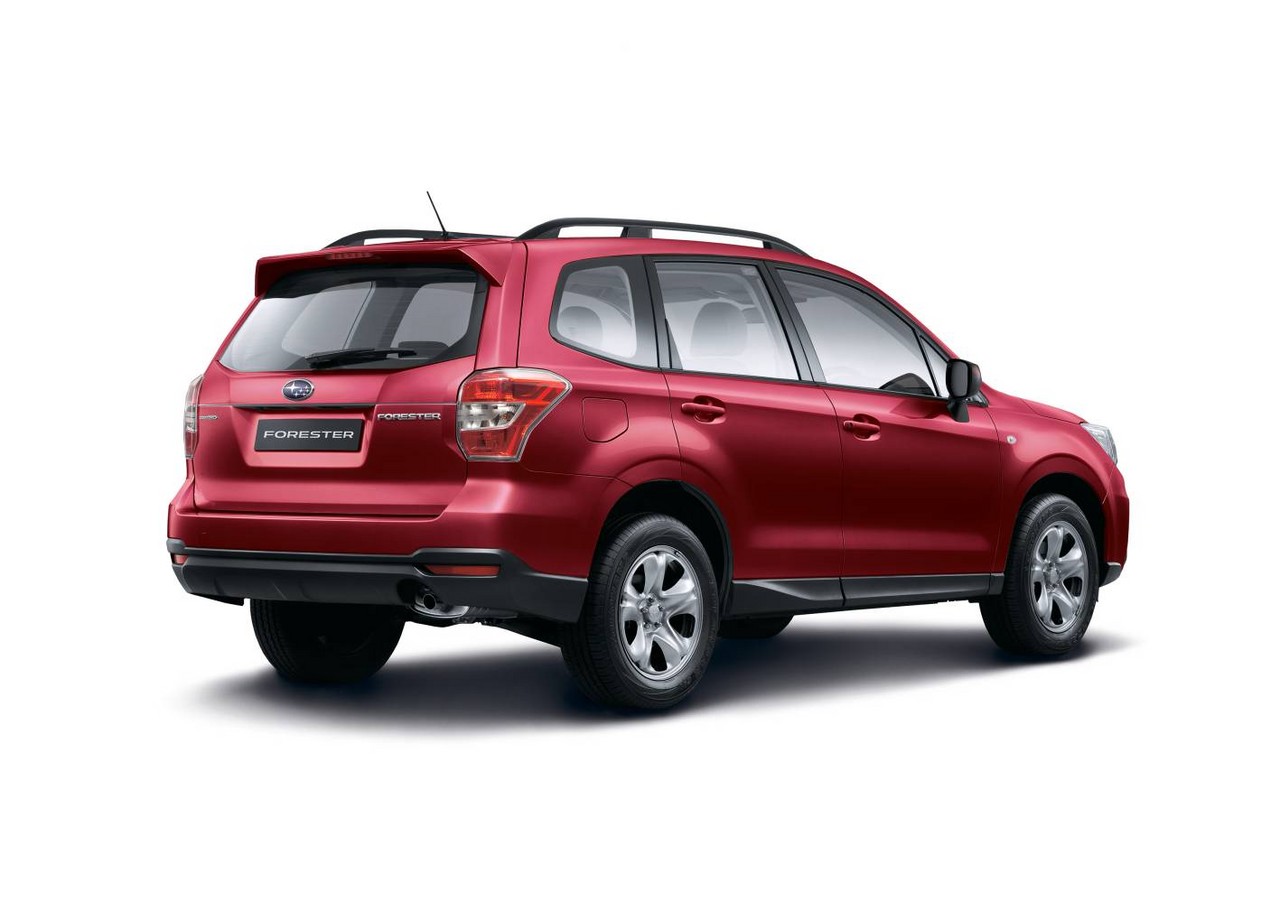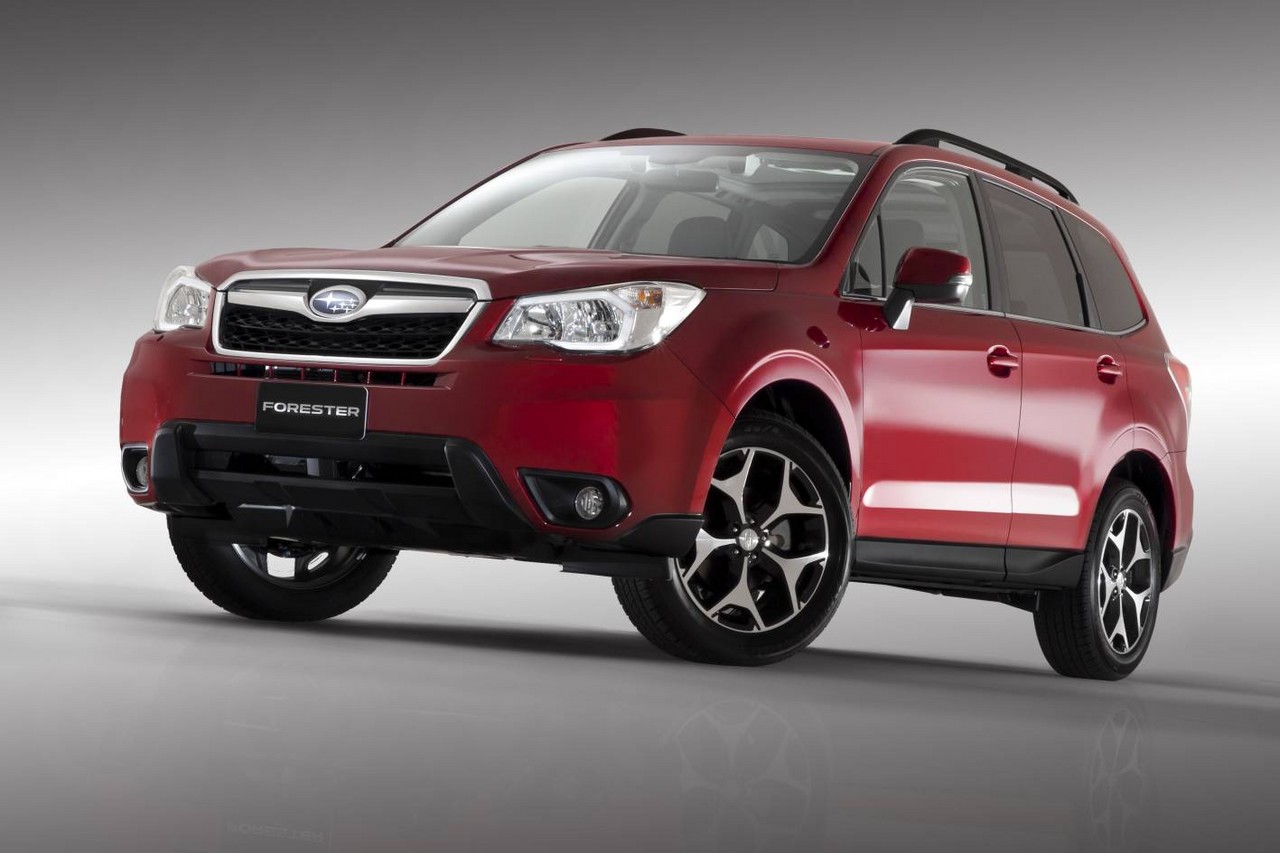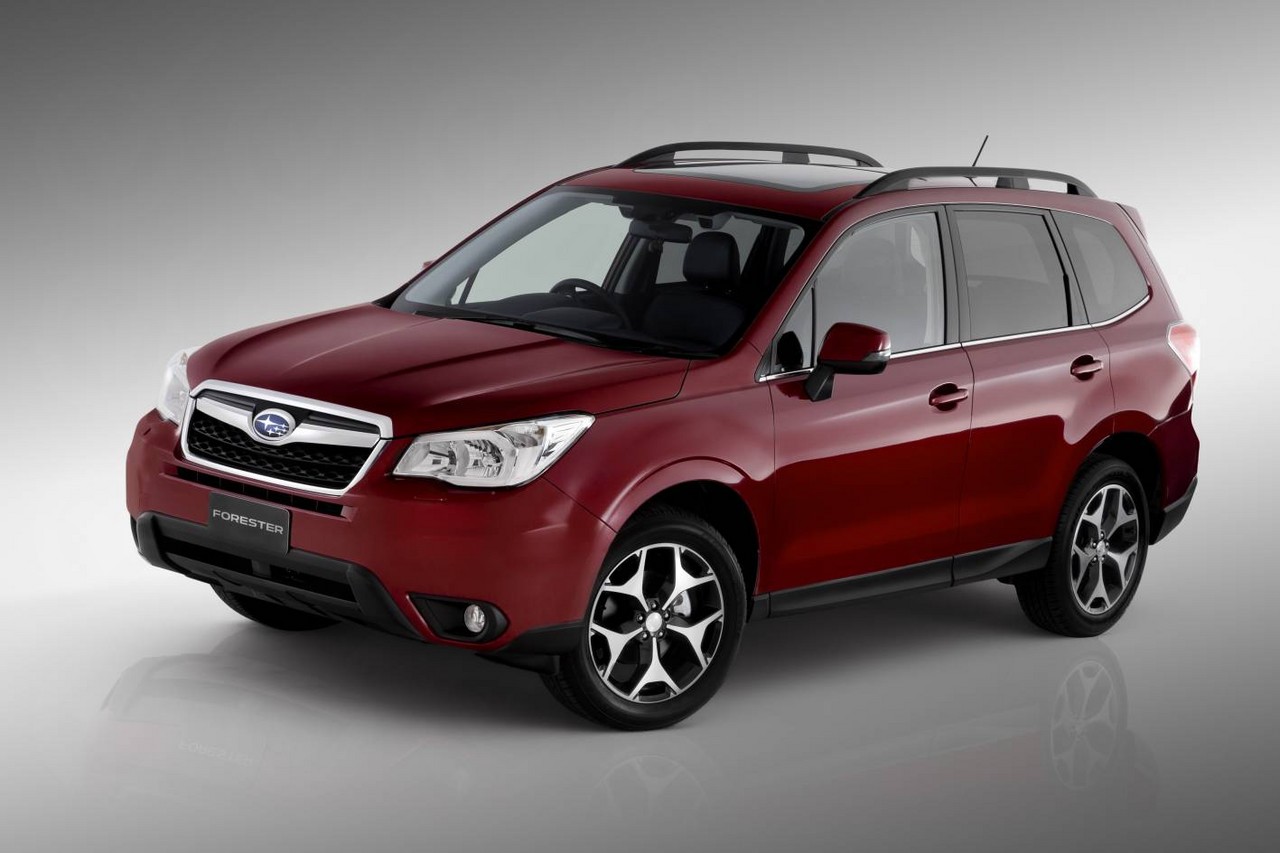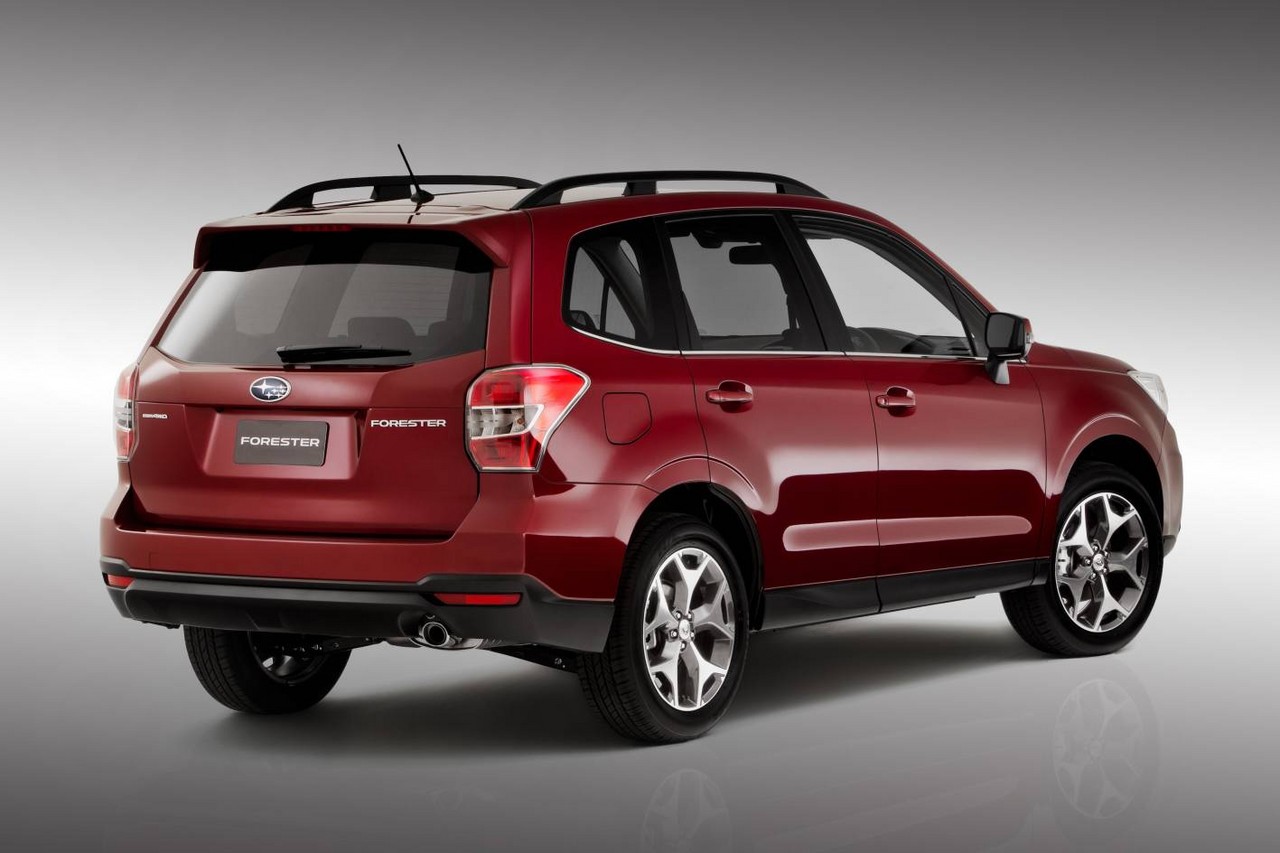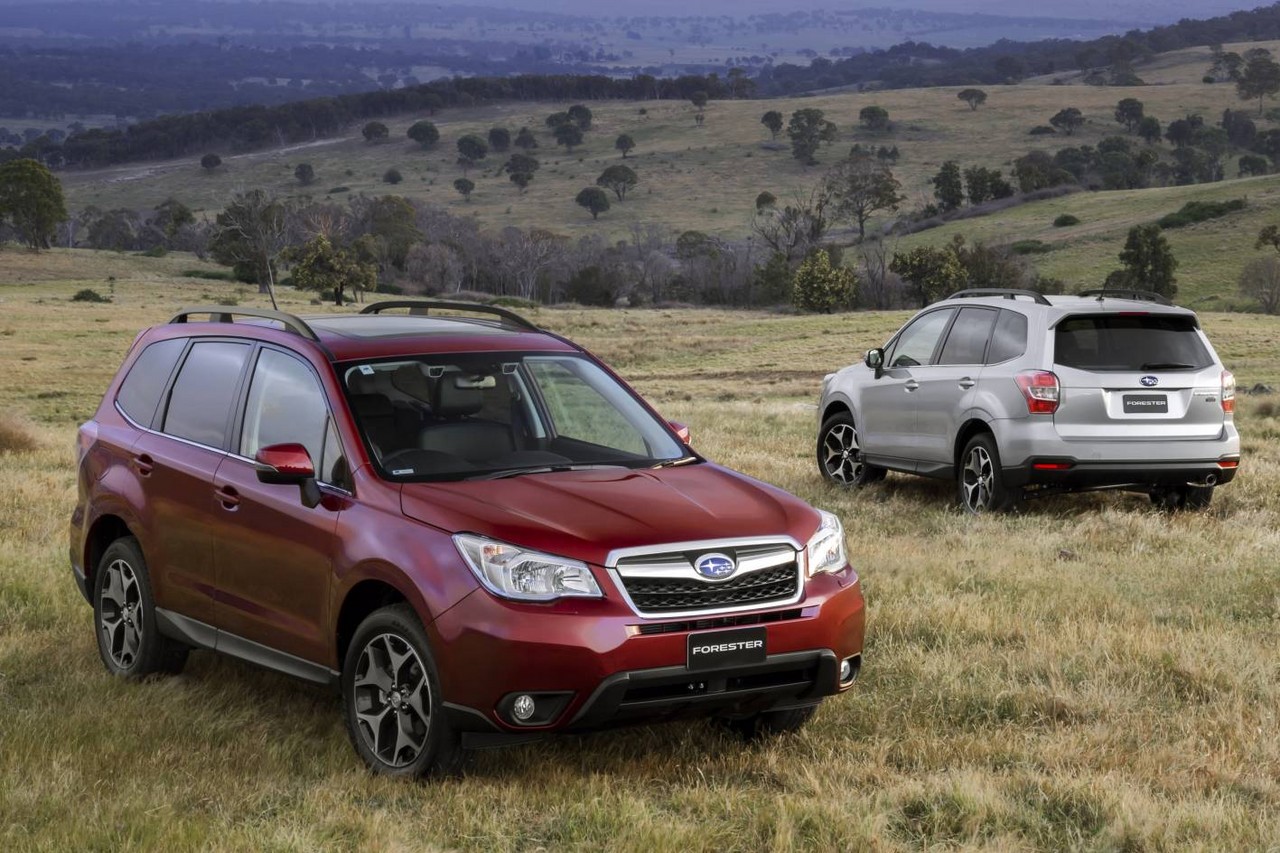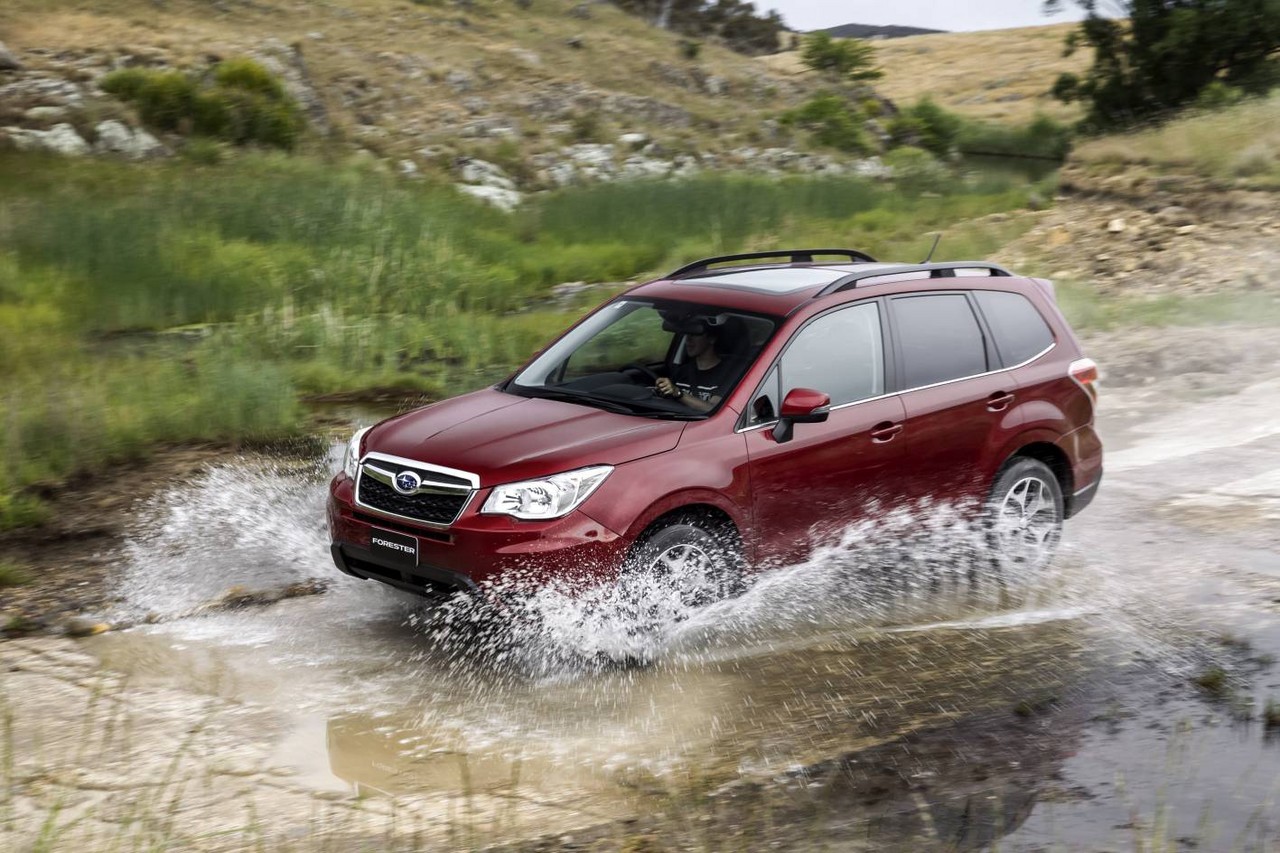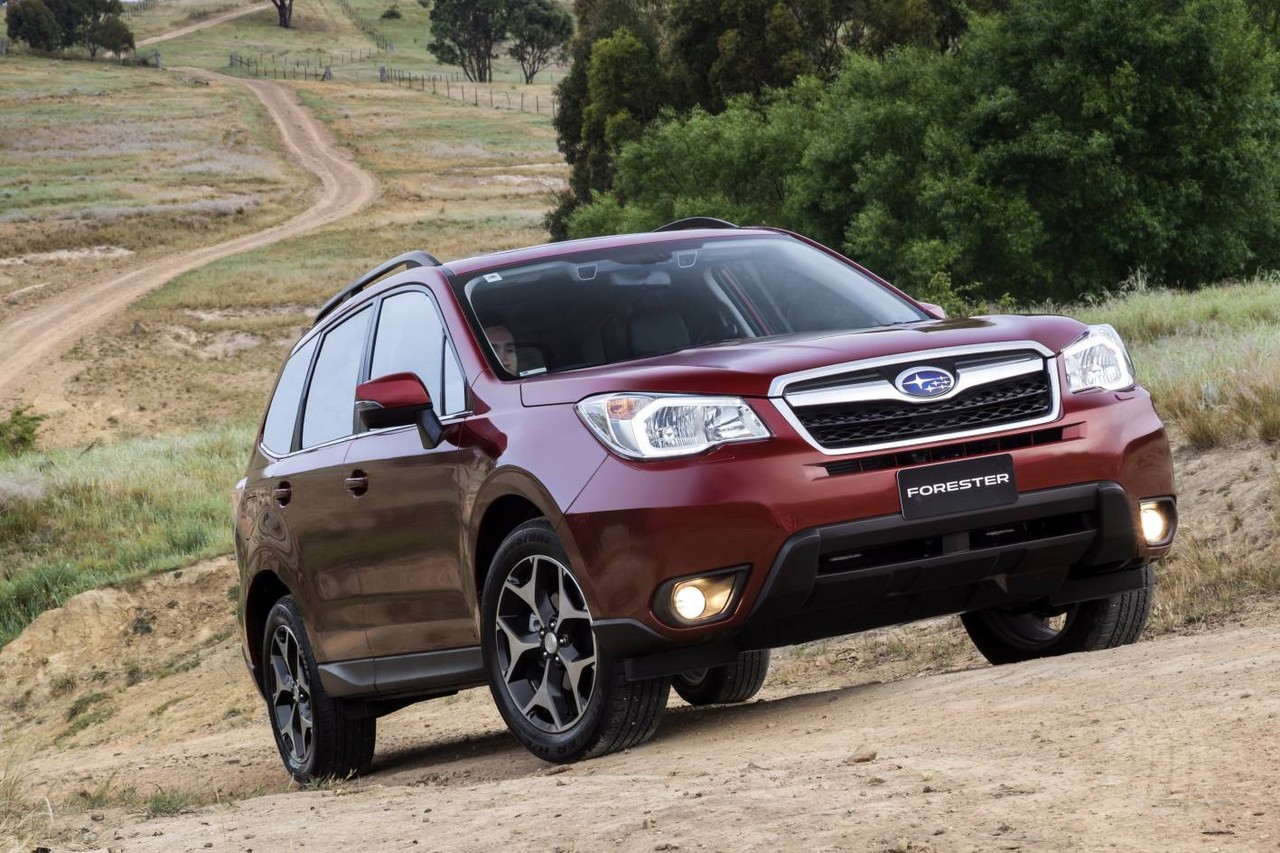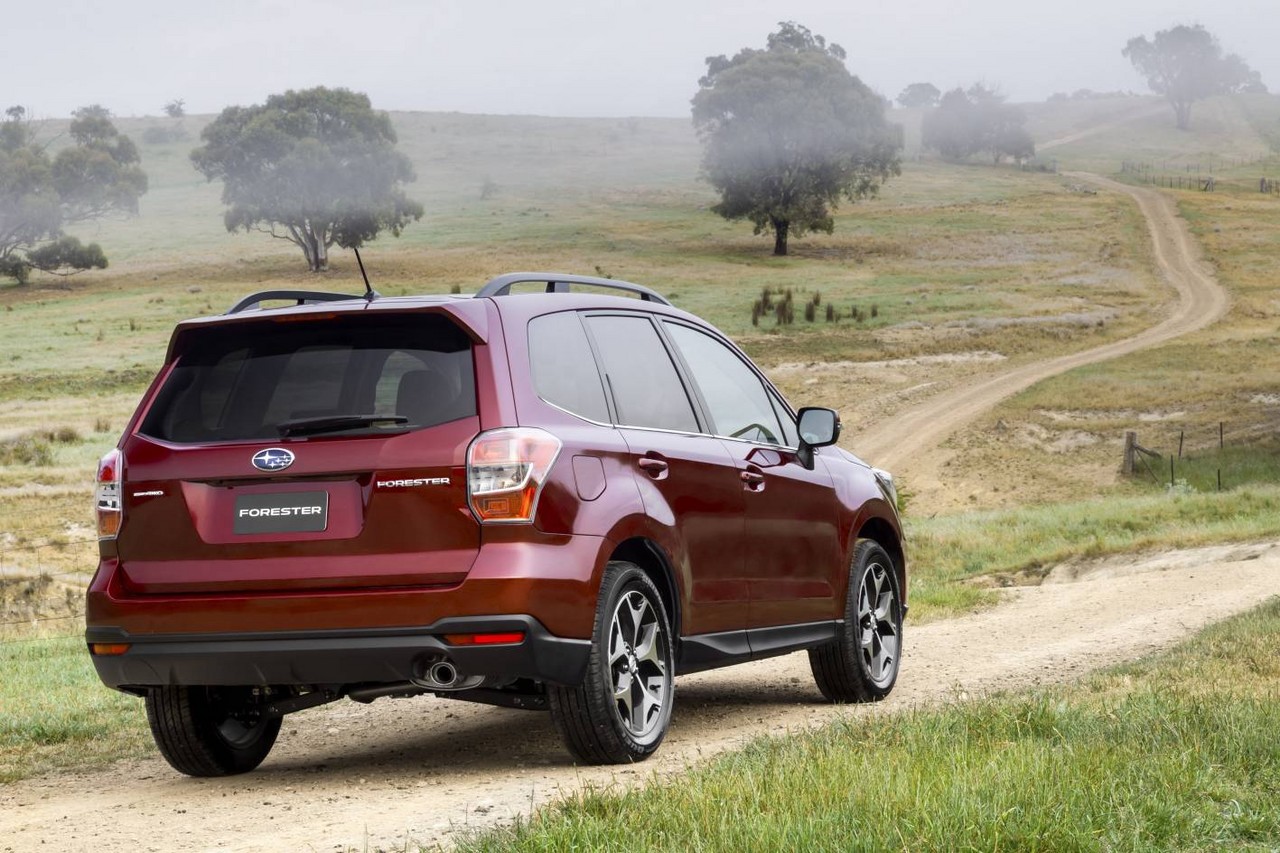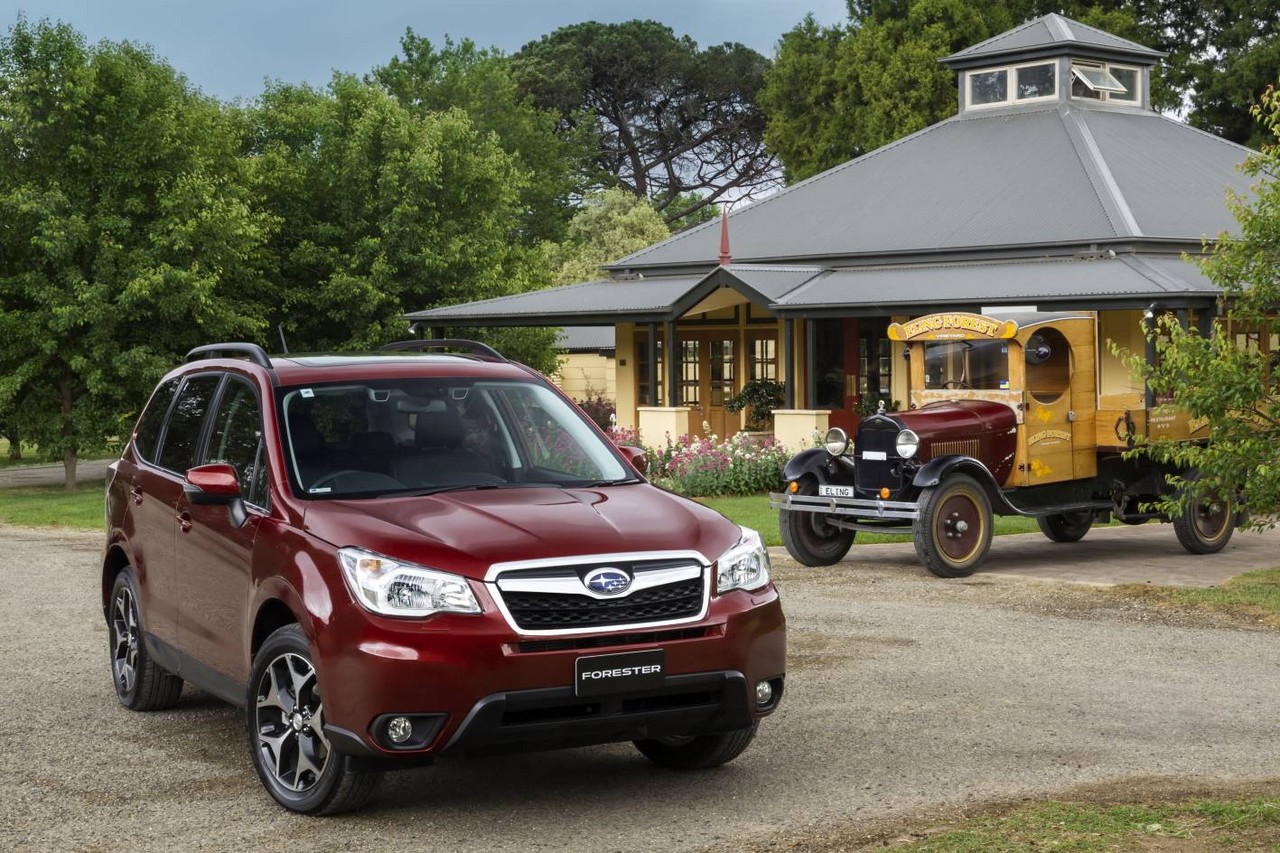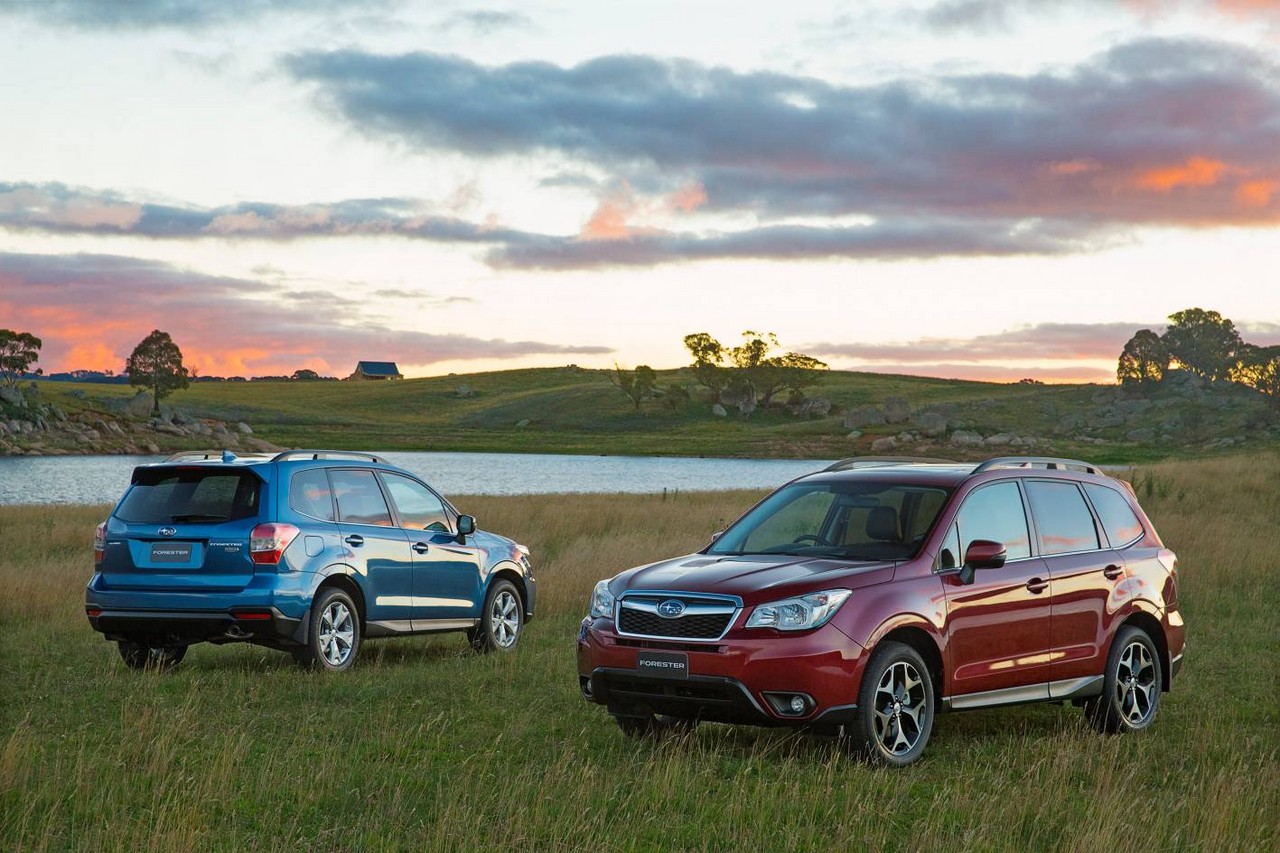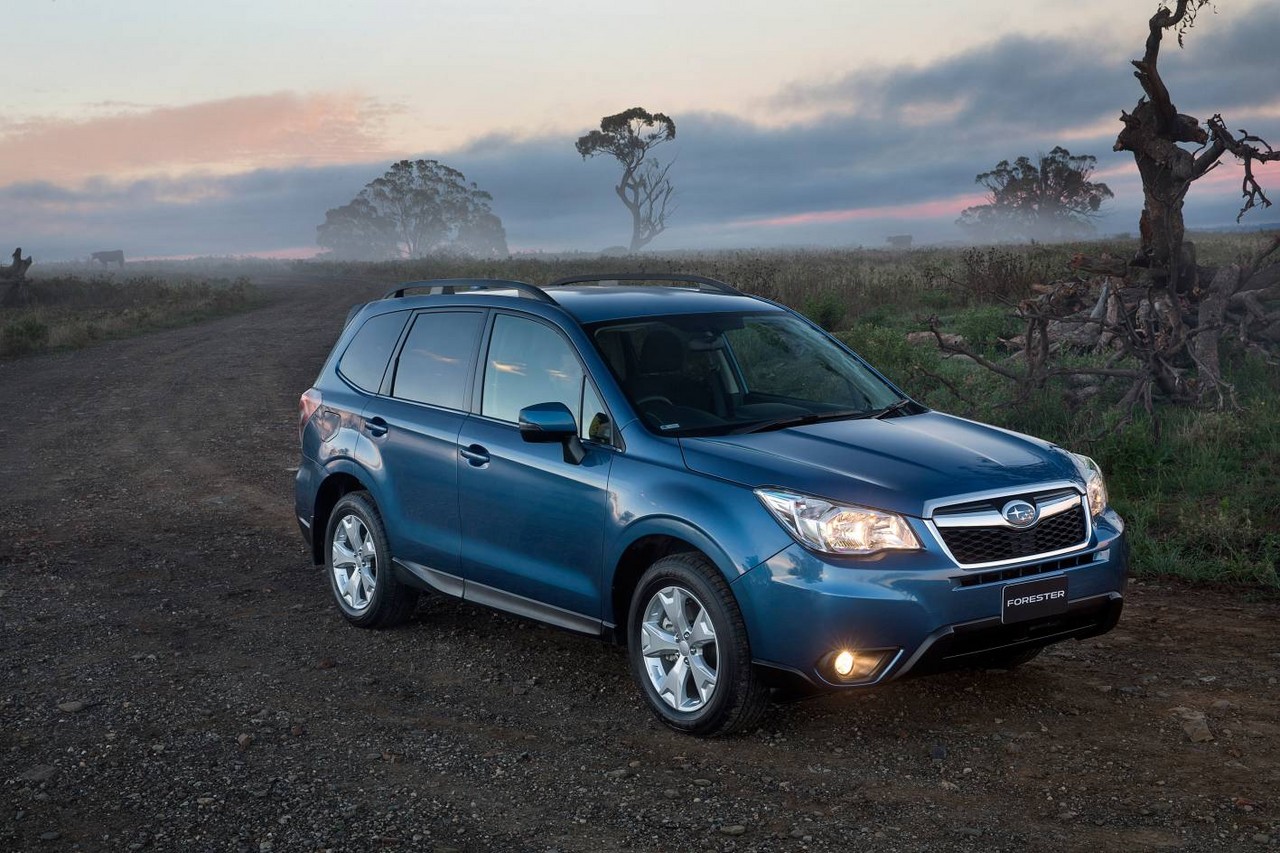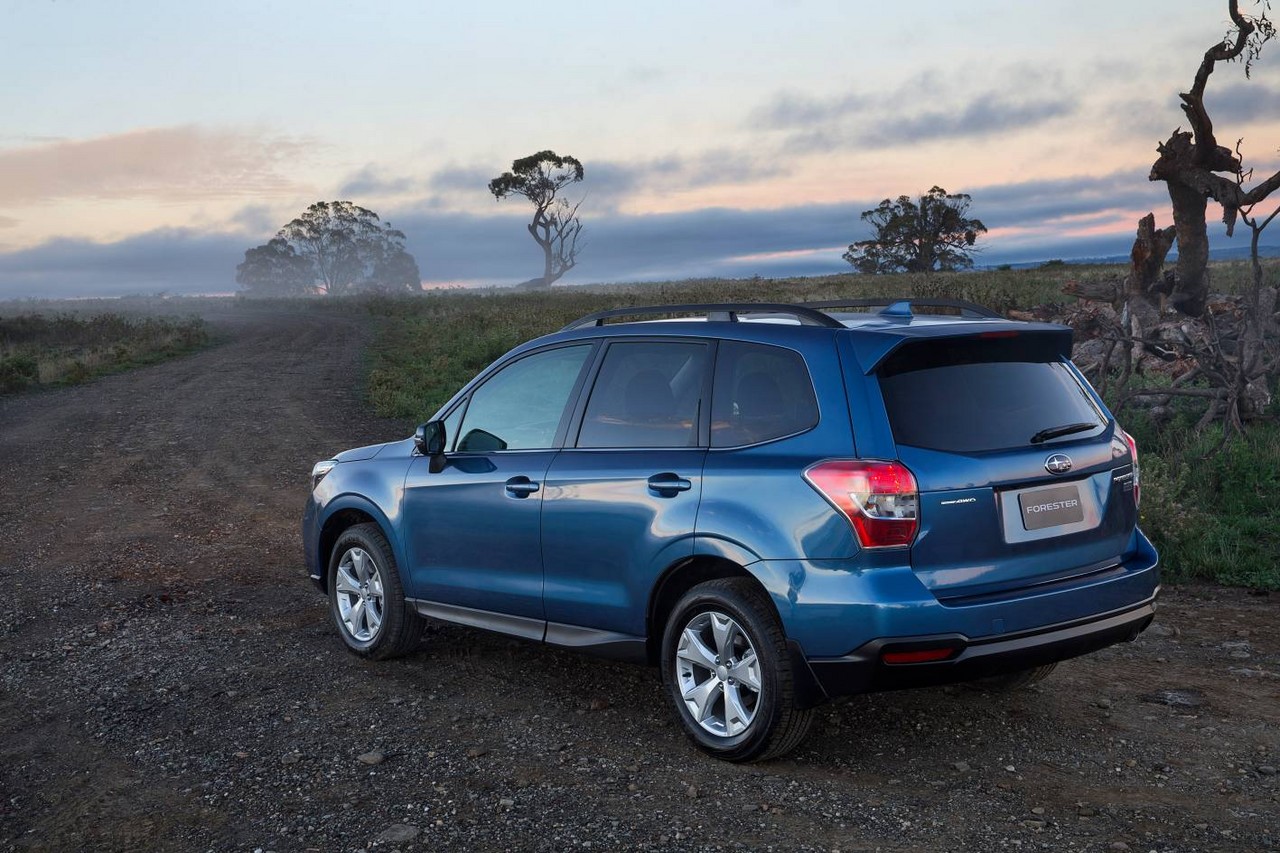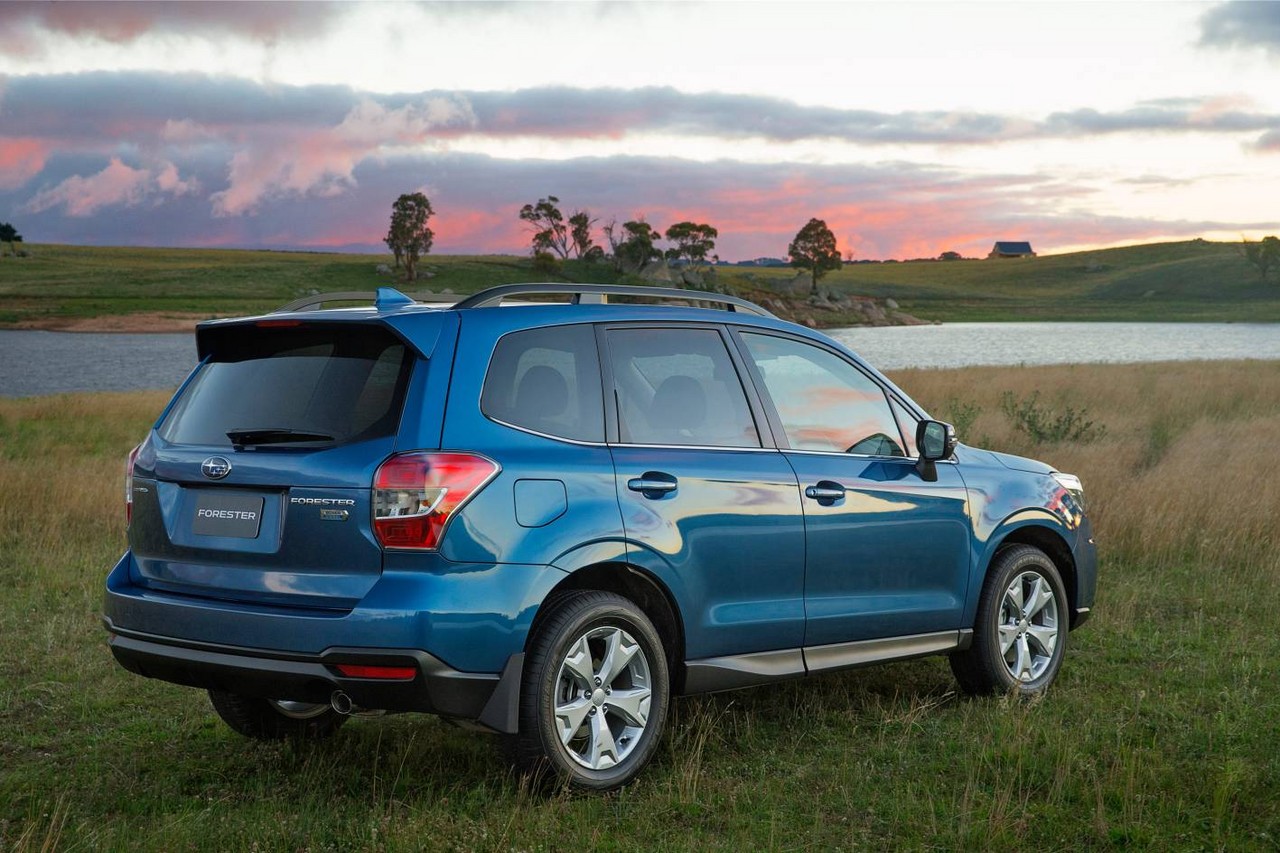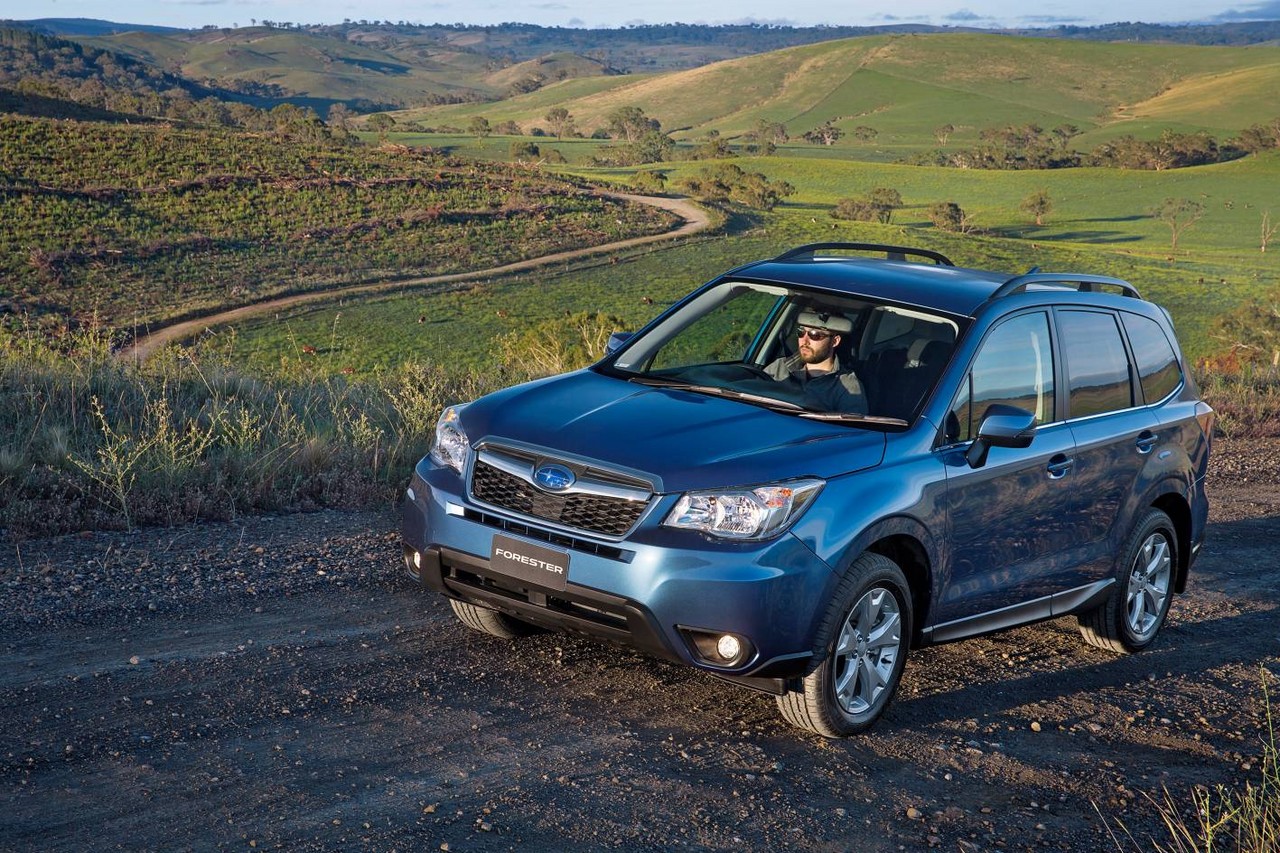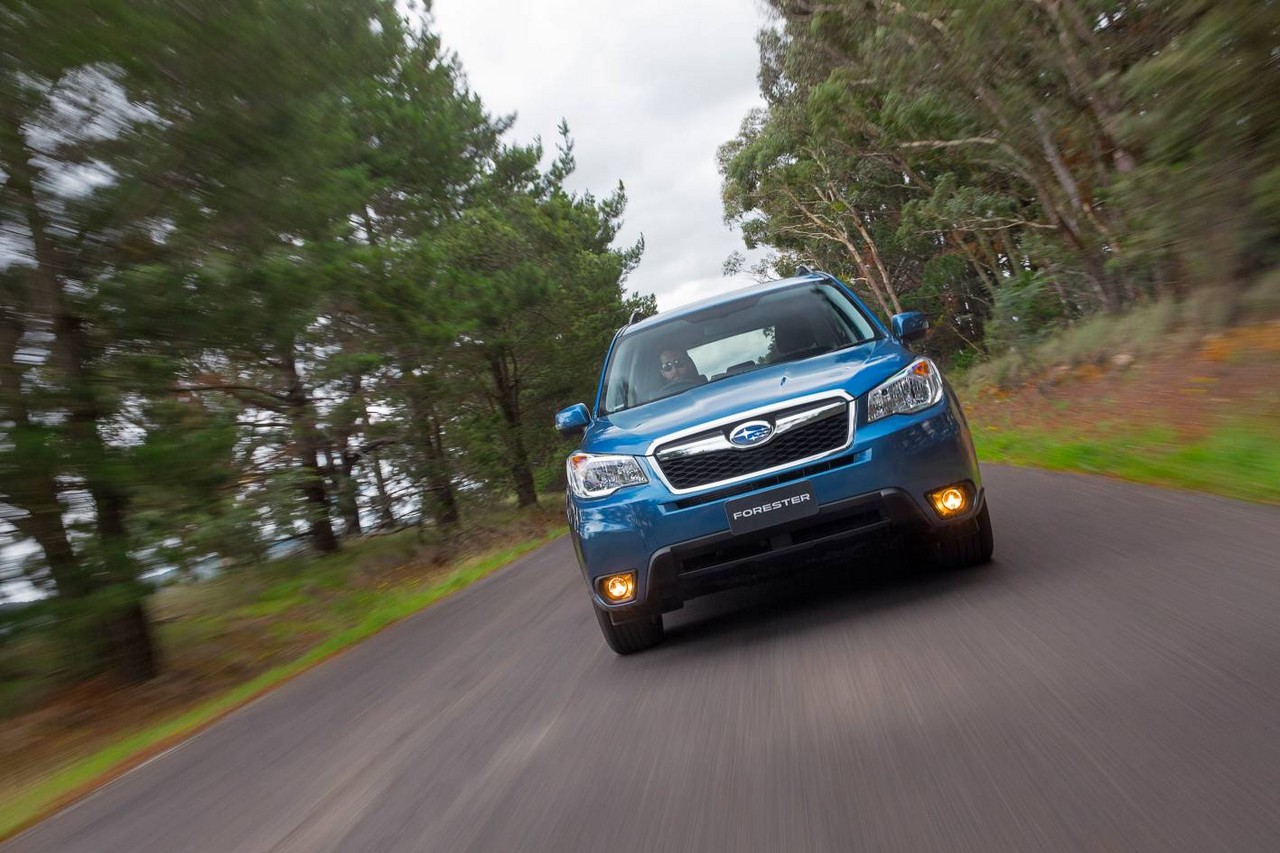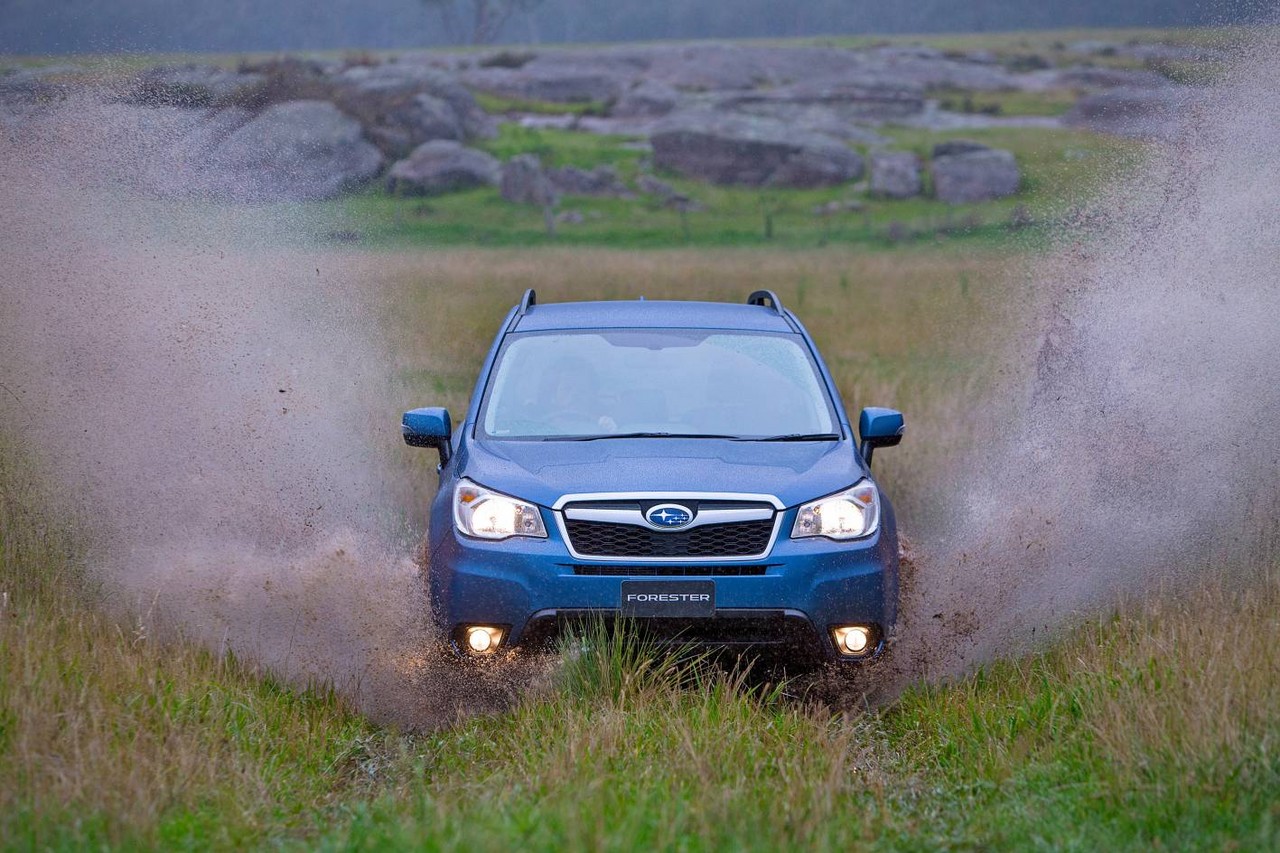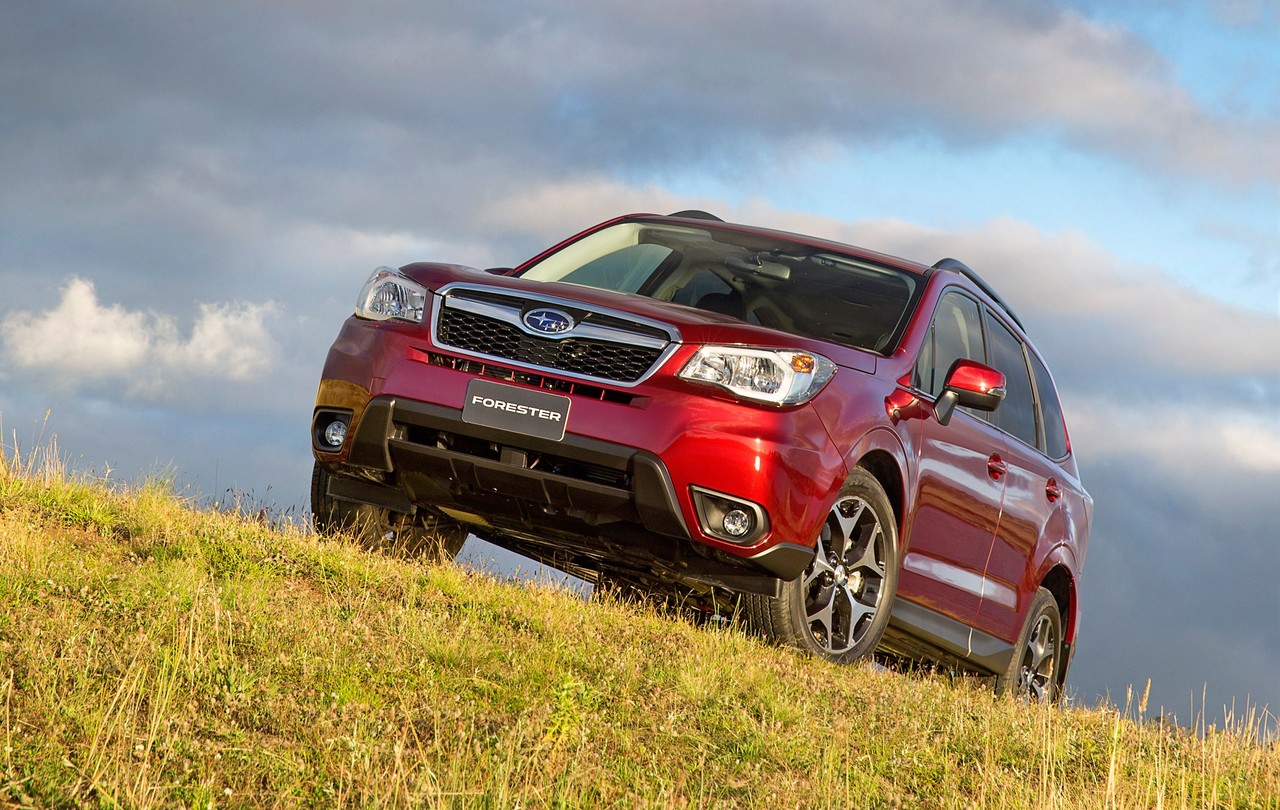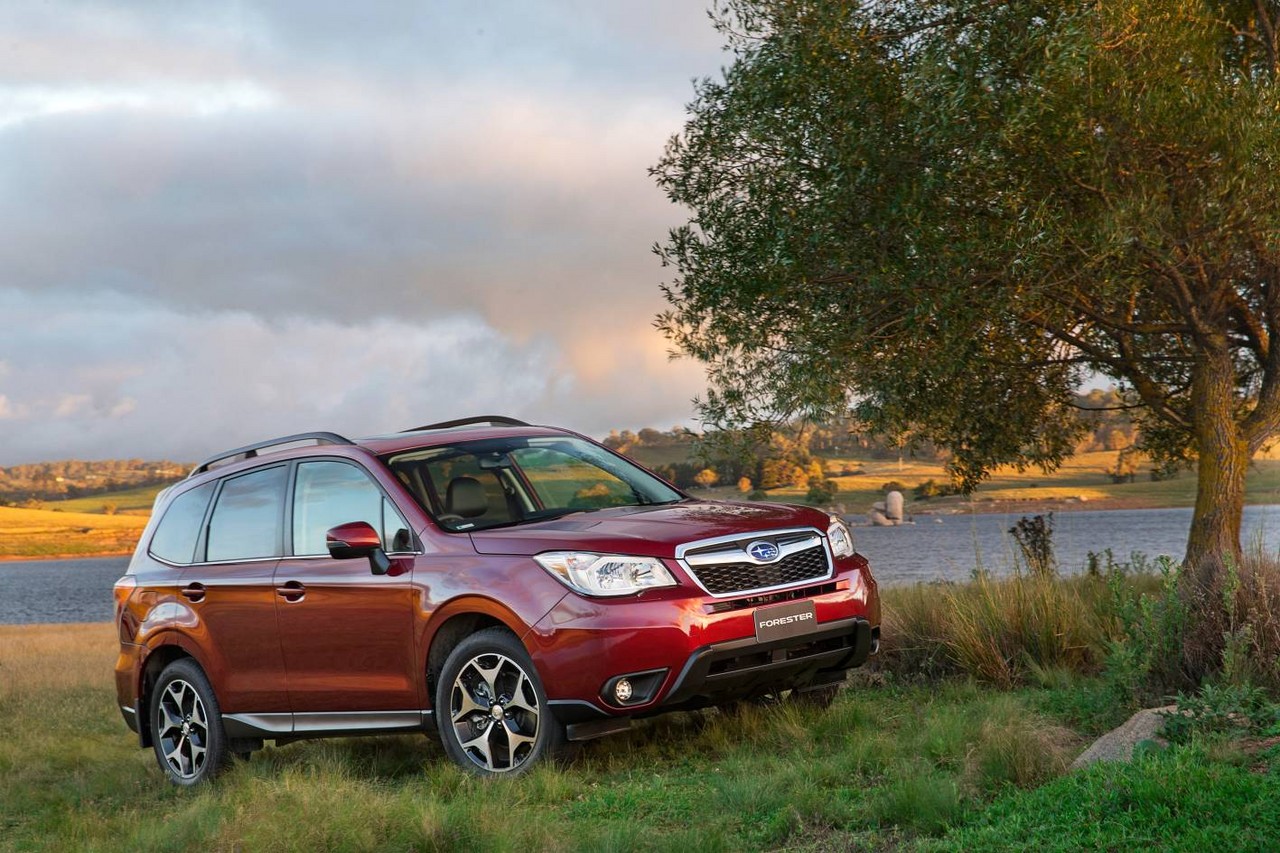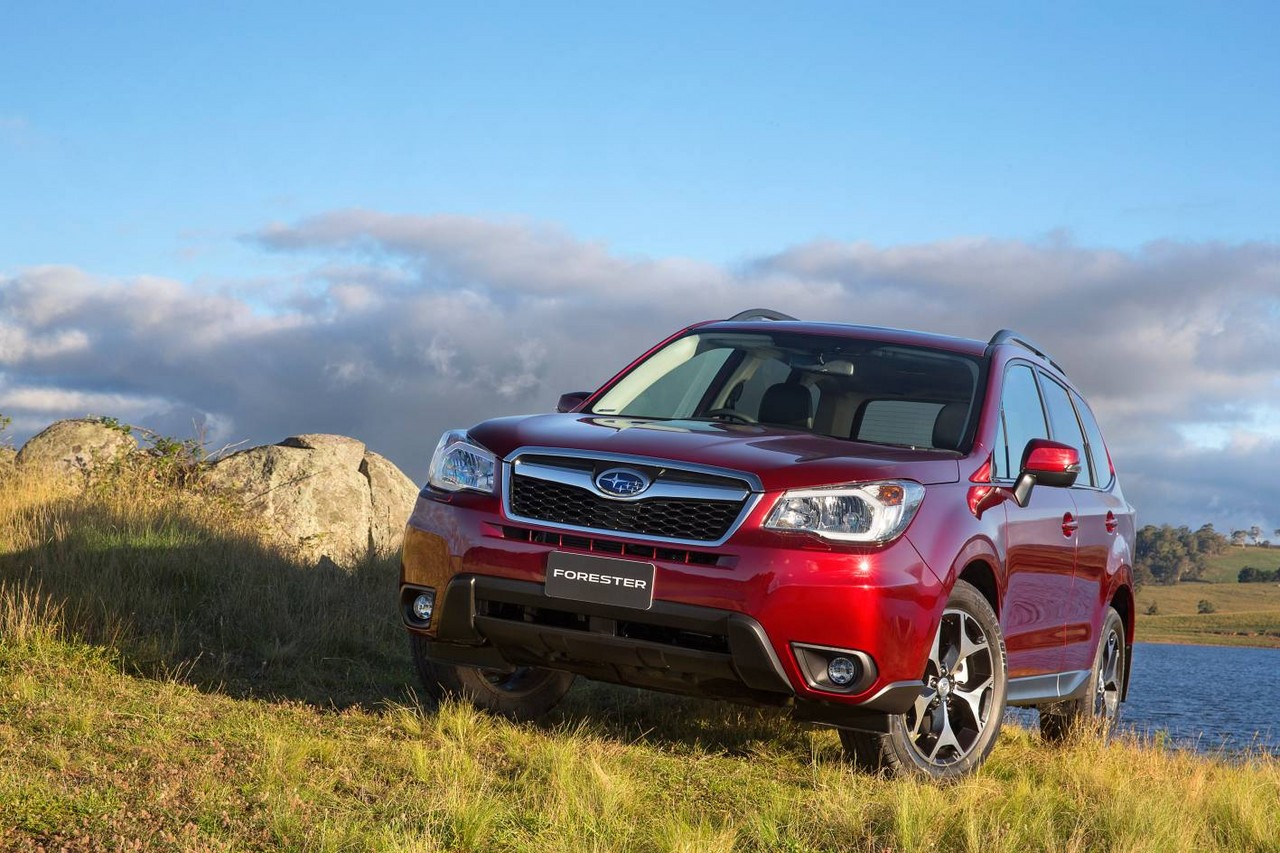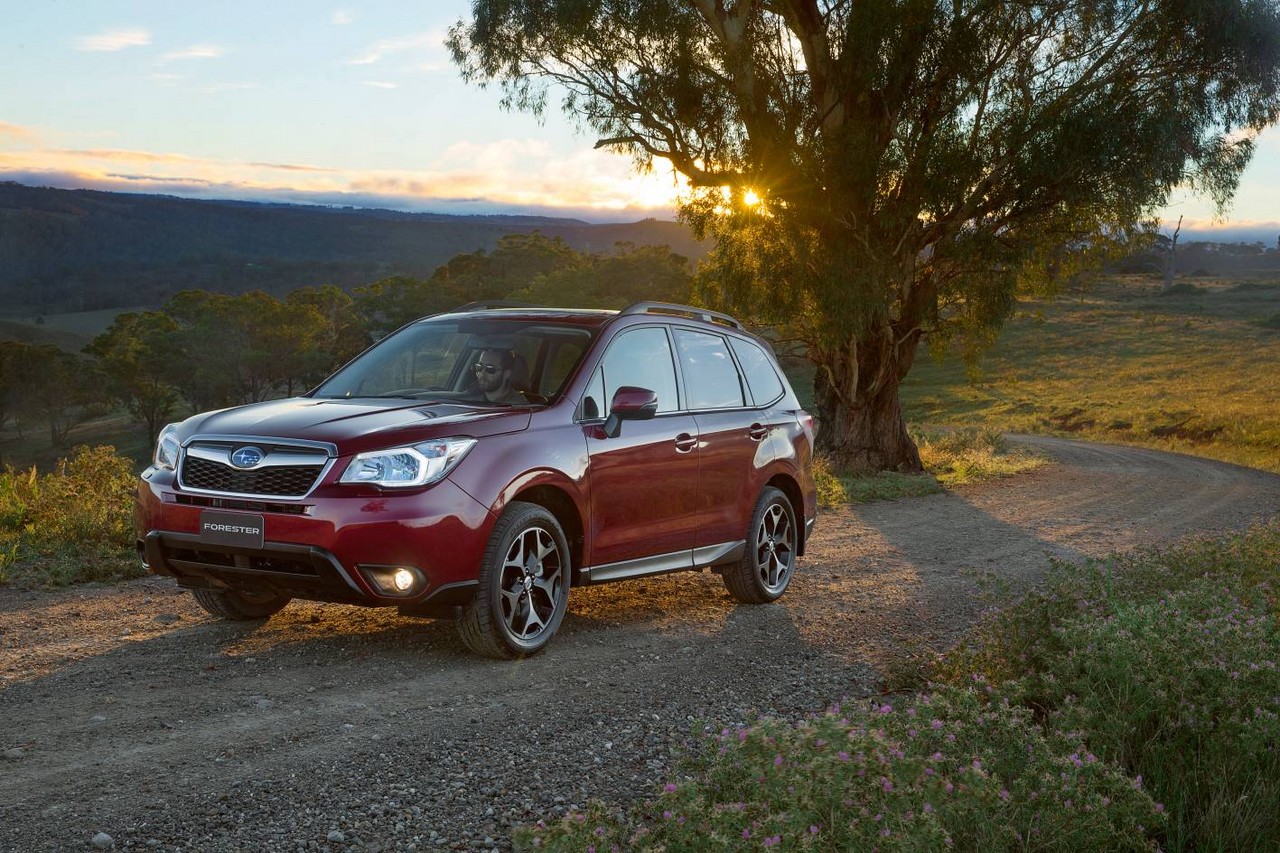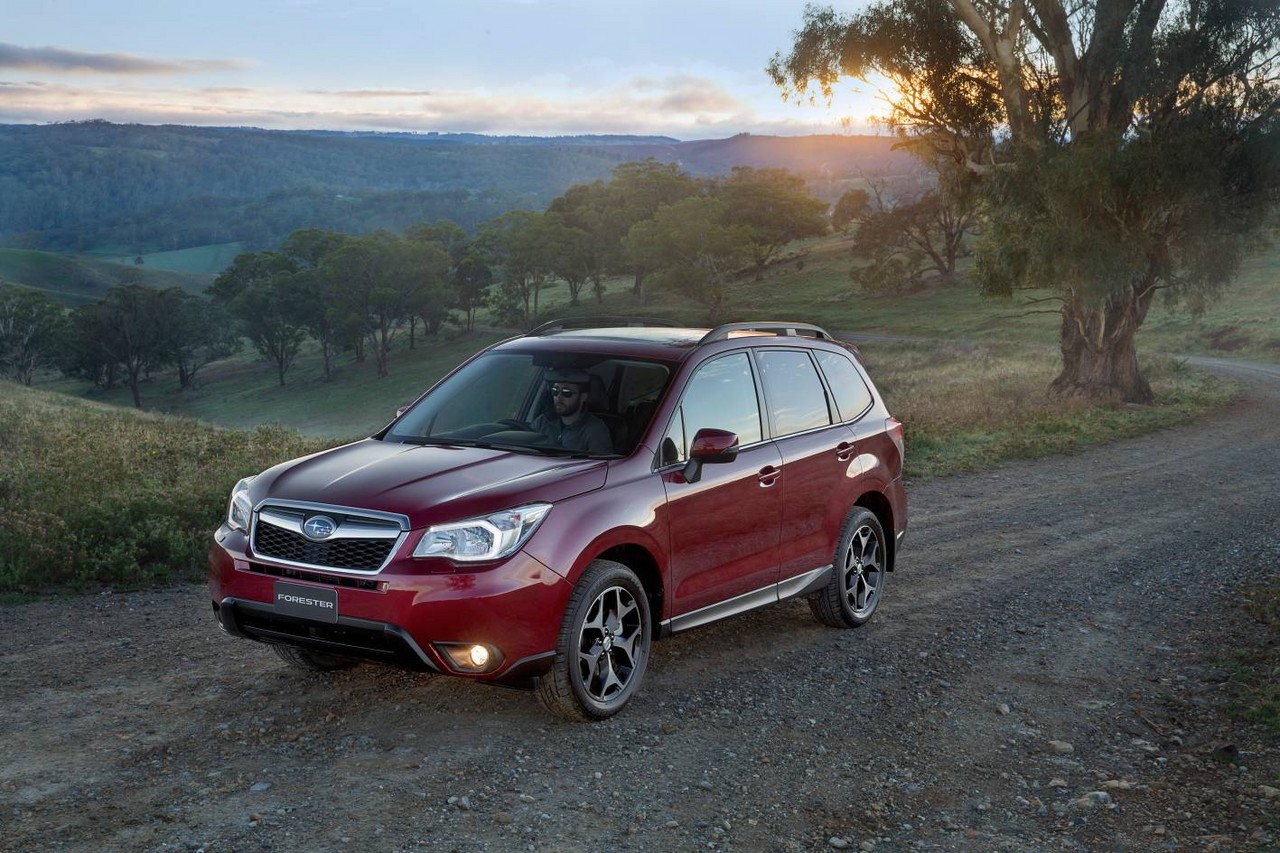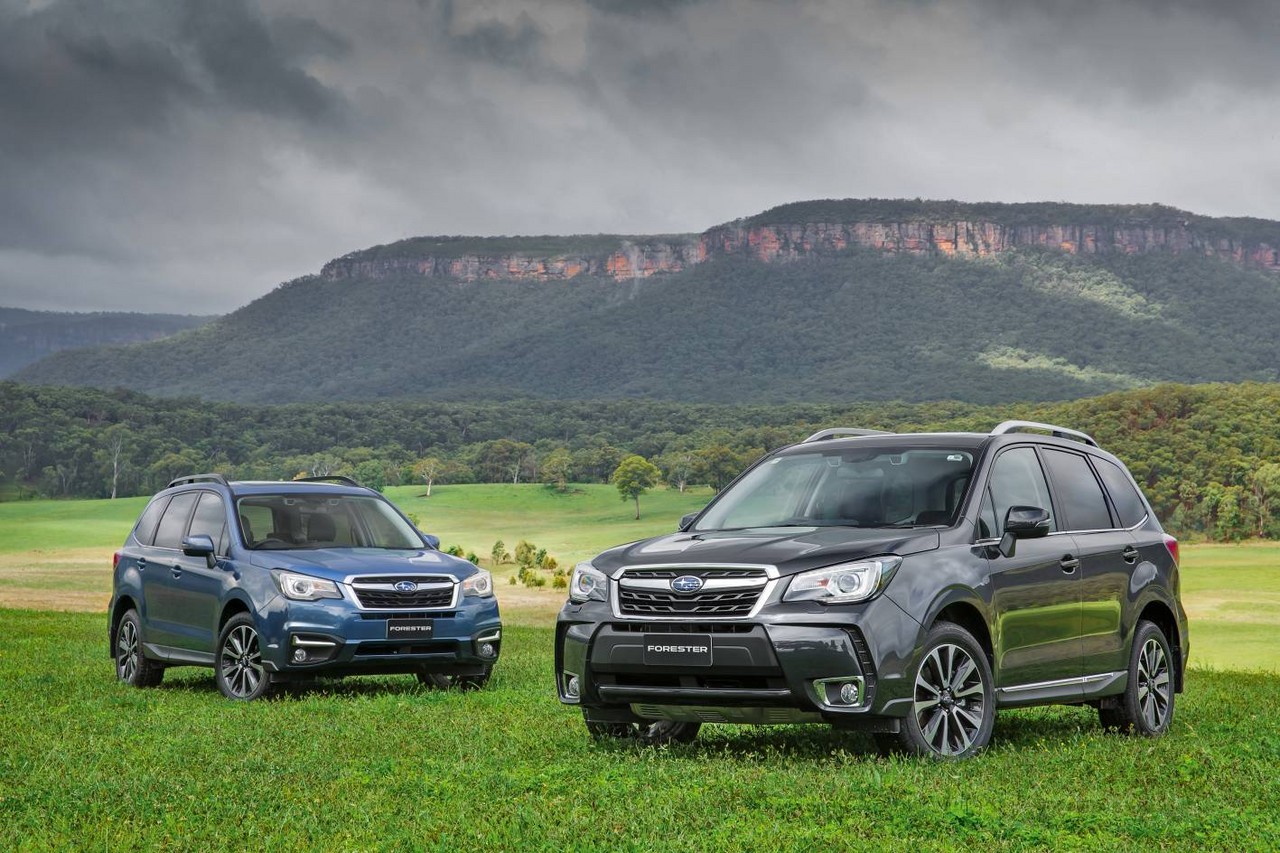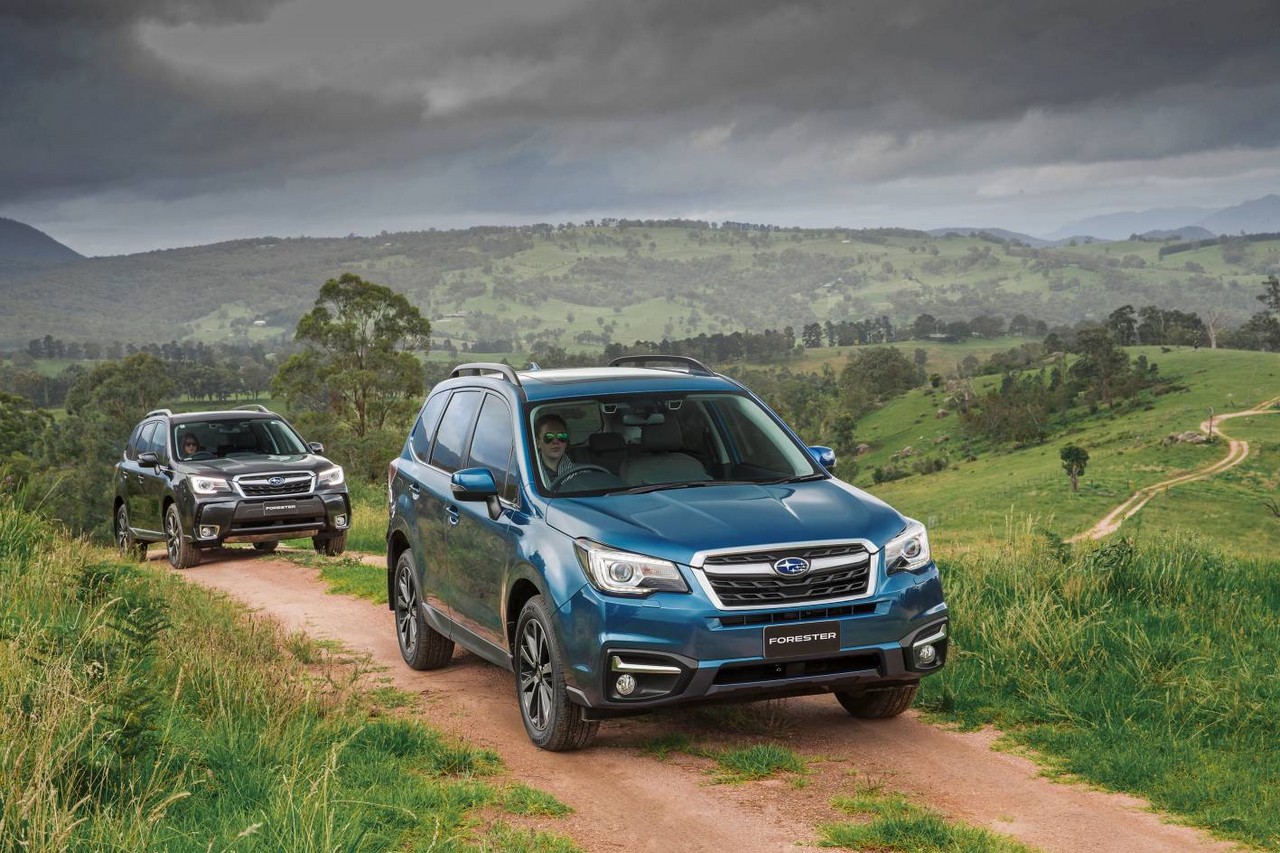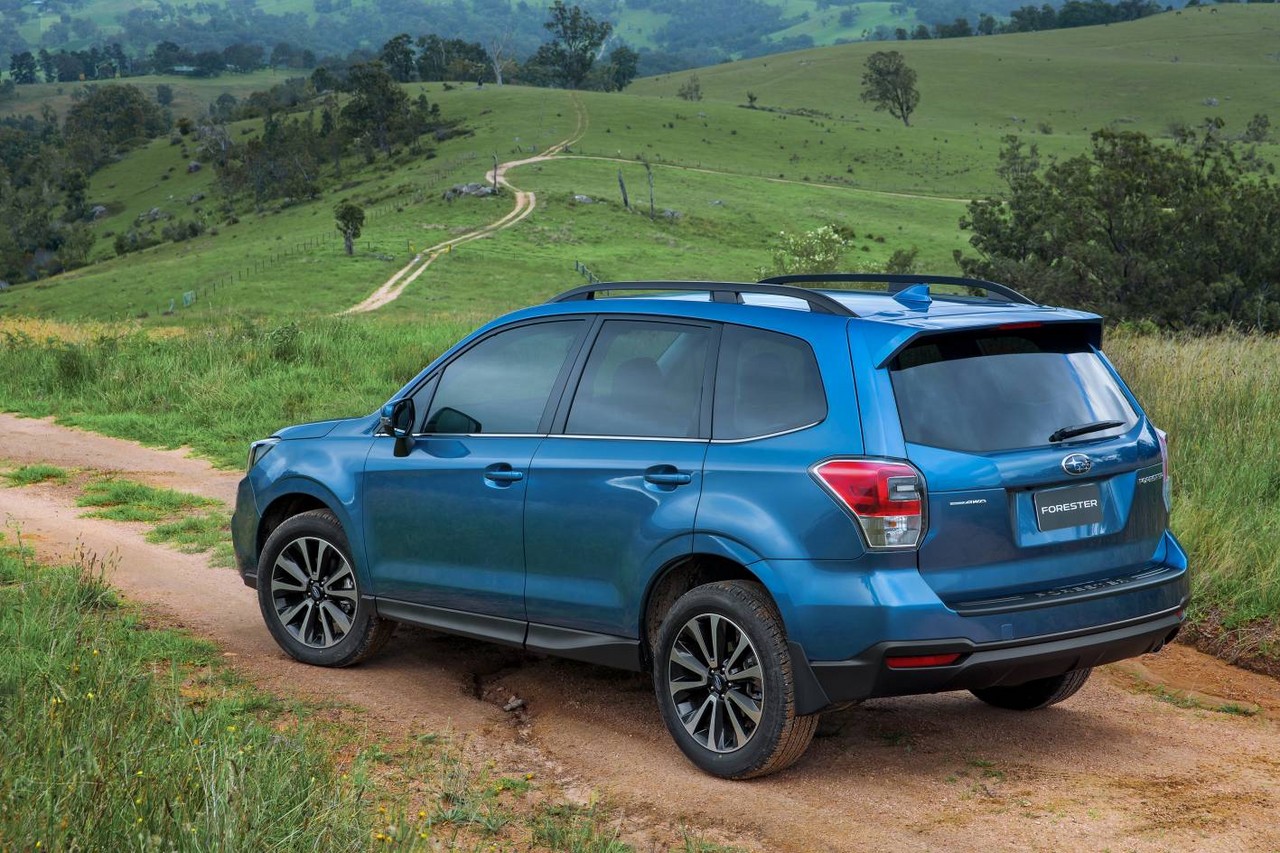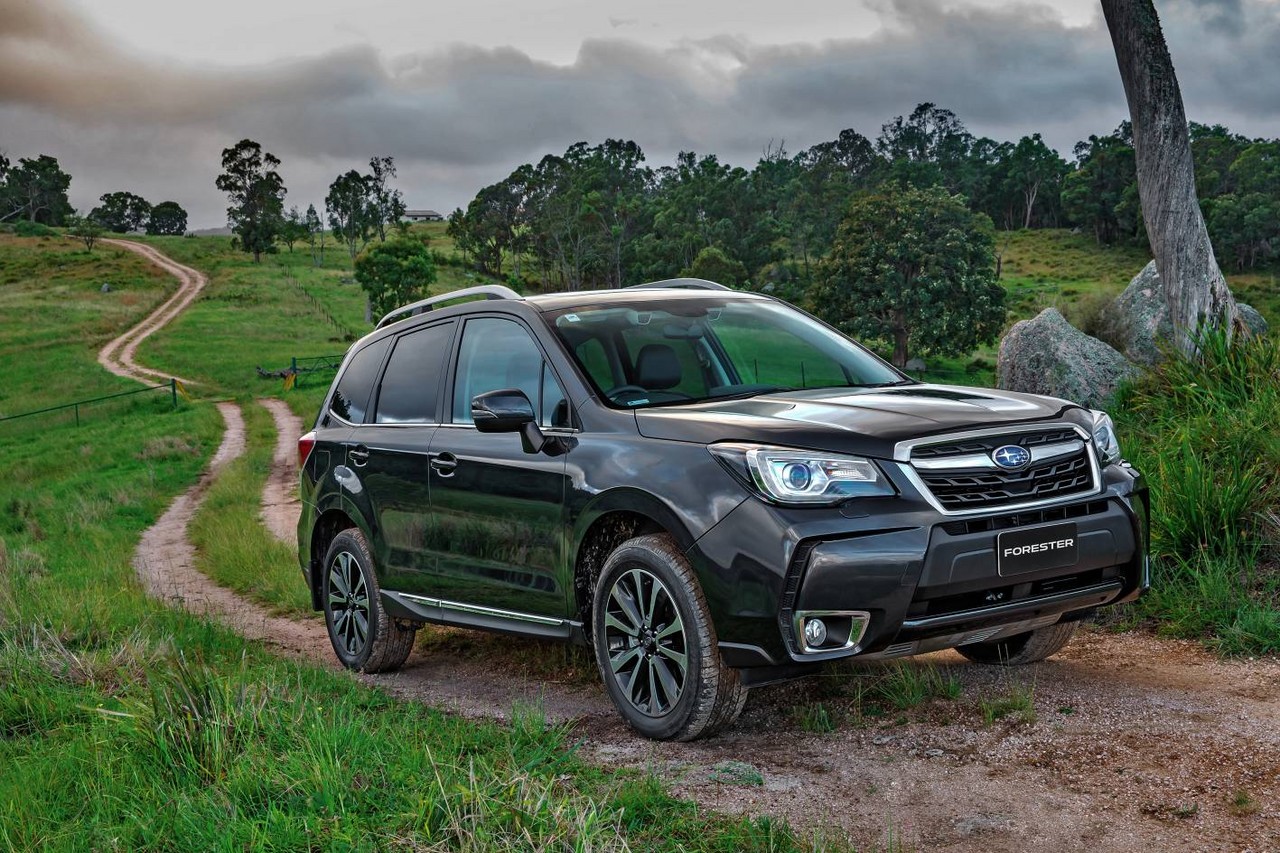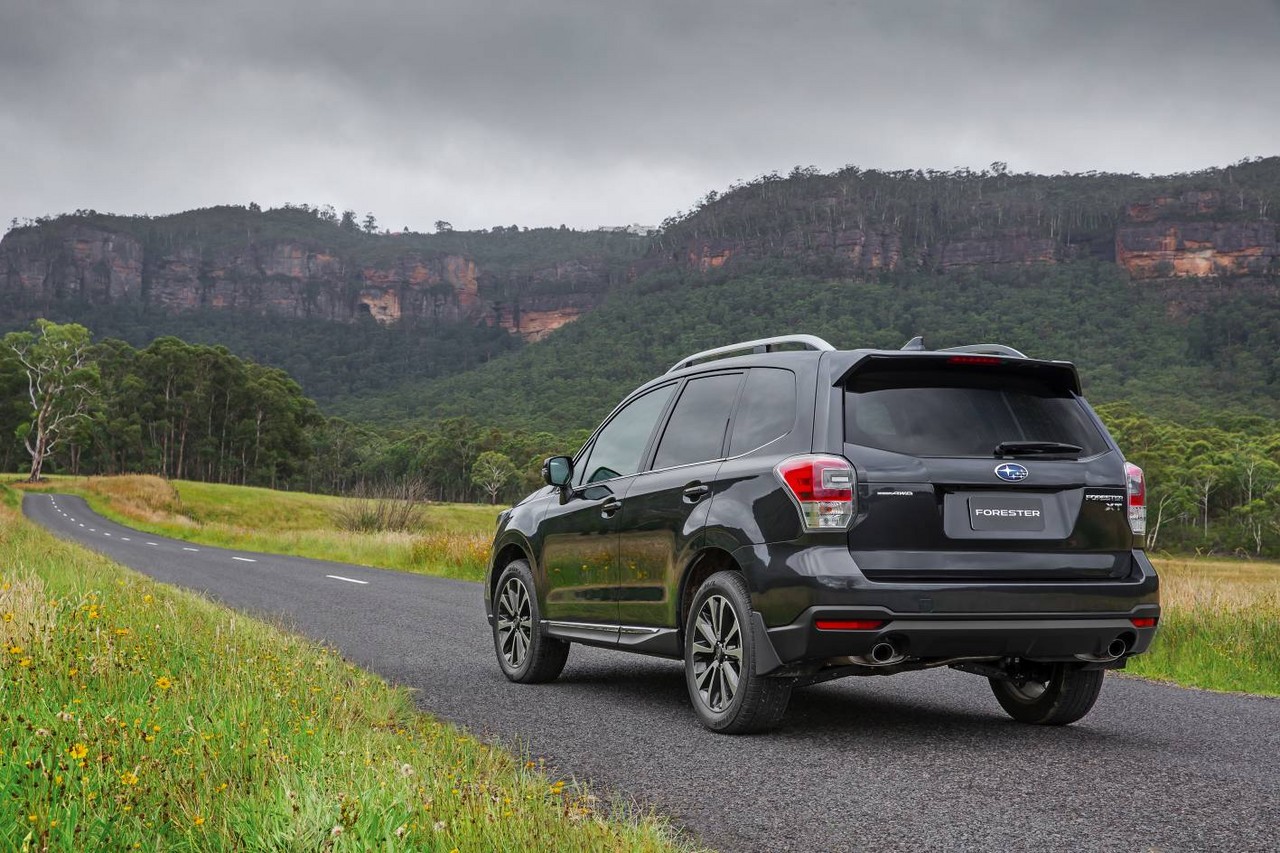
- Forester XT has powerful 2.0-litre turbo petrol engine
- Six-speed manual transmission is easy to use
- Spacious interior
- Well-weighted, accurate steering
- Generally impressive ride/handling balance…
- … though suspension lacks low-speed compliance
- Diesel engine lacks low-rev response with manual transmission
- Front seats lack support
- Tyre noise on coarse chip surfaces
- Reports of high oil consumption for 2.0-litre petrol engine
Review: Subaru SJ.I Forester (2013-15)
Overview
Released in February 2013, the Subaru SJ Series I (SJ.I) Forester was a mid-size, all-wheel drive SUV. Manufactured in Gunma, Japan, the all-wheel drive Subaru SJ Forester was available with naturally aspirated 2.0- and 2.5-litre petrol engines, a 2.0-litre turbo-diesel unit or a 2 0-litre turbocharged petrol engine for the Forester XT. The full SJ Forester range is given in the table below.
FB20, FB25, FA20E and EE20 engines
Of the engines,
- The 2.0-litre FB20 flat four-cylinder petrol engine had an open-deck aluminium alloy block double overhead camshafts (chain-driven), four valves per cylinder, variable intake and exhaust valve timing (Subaru’s ‘Dual Active Valve Control System’) and a compression ratio of 10.5:1. To minimise fuel consumption, the FB20 engine also had an ‘Auto Start Stop’ function which enabled it to shut down when the Forester was stationary in traffic;
- The 2.5-litre FB25 engine had an open-deck aluminium alloy cylinder block, aluminium alloy cylinder head, double overhead camshafts, four valves per cylinder actuated by roller rocker arms, Subaru’s ‘Dual Active Valve Control System’ (for variable intake and exhaust valve timing), a compression ratio of 10.0:1 and an Auto Start Stop function;
- For the Forester XT, the 2.0-litre FA20E engine had an open-deck aluminium cylinder block, a Garrett MGT2259S twin-scroll turbocharger which provided peak boost pressure of 1.18 bar (17.1 psi), double overhead camshafts (chain-driven), four valves per cylinder, variable intake and exhaust valve timing (Subaru’s ‘dual AVCS’), direct fuel injection and a compression ratio of 10.6:1; and,
- The 2.0-litre EE20 diesel engine had common-rail injection (operating at 1800 bar), a variable geometry turbocharger, double overhead camshafts (chain-driven), four valves per cylinder and a compression ratio of 16.3:1.
| Engine | Variant | Trans. | Peak power | Peak torque |
|---|---|---|---|---|
| 2.0-litre FB20 petrol F4 | 2.0i, 2.0i-L |
6sp man. | 110 kW at 6200 rpm | 198 Nm at 4200 rpm |
| 2.5-litre FB25 petrol F4 | 2.5i, 2.5i-L, 2.5i-S |
CVT | 126 kW at 5800 rpm | 235 Nm at 4100 rpm |
| 2.0-litre EE20 turbo-diesel F4 | 2.0D, 2.0D-L, 2.0D-S |
6sp man. | 108 kW at 3600 rpm | 350 Nm at 1600-2400 rpm |
| 2.0-litre FA20E turbo petrol F4 | XT, XT Premium |
CVT | 177 kW at 5600 rpm | 350 Nm at 2400-3600 rpm |
Dimensions
Compared to the Subaru SH Forester , the SJ Forester was 35 mm longer (at 4595 mm), 1 mm wider (1796 mm) and had a 25 mm longer wheelbase (2640 mm); ground clearance also increased by 5 mm to 220 mm, while the Forester body had a drag coefficient of 0.33 Cd.
Steering and suspension
The Subaru SJ Forester had electric power-assisted steering, MacPherson strut front suspension and double wishbone rear suspension.
All-wheel drive systems
For Subaru SJ Forester models with manual transmissions, the all-wheel drive system utilised a viscous limited slip differential. In normal conditions, the system provided a 50:50 front/rear torque split though, in the event that traction was lost, the viscous coupling enabled torque to be redirected to the wheels with grip.
For SJ Forester models with continuously variable transmissions (CVTs), there was an ‘Active Torque Split’ system which used a multi-plate clutch. In normal conditions, the system provided a default front/rear torque split of 60:40, though this could be varied according to traction and driving conditions. Models with the CVT also had a selectable off-road ‘X-Mode’ drive setting; at speeds below 40 km/h, X-Mode
- limited throttle response to avoid torque surges;
- increased AWD clutch pressure by approximately 25 per cent to control differential rotation between the front and rear wheels; and,
- counteracted differential rotation between left and right wheels by accelerating brake boosting speed and delaying reduction of brake pressure when wheel rotation returns to normal.
At speeds below 20 km/h, X-Mode used the hill descent control function to control braking on steep hills so that vehicle speed could be maintained without throttle or brake inputs from the driver.
Safety equipment
Standard safety equipment for the Subaru SJ Forester included dual front airbags, a driver’s knee airbag, front side airbags, full-length curtain airbags (i.e. for front and rear occupants), ABS, electronic brake force distribution, brake assist, electronic stability control, traction control and front seatbelts with pretensioners (double pretensioners for the driver) and load limiters.
The 2.5i-S and 2.0 XT Premium variants were also fitted with Subaru’s ‘EyeSight’ system which used minute sound system cameras to detect road hazards and alert the driver. As such, the EyeSight system included:
- Pre-Collision Brake Assist which could generate 1G maximum deceleration when the driver applied the brakes if a collision was considered to be highly likely;
- Pre-Collision Braking which automatically applied the brakes when a vehicle ahead was detected to be decelerating and the driver had failed to apply the brakes. EyeSight could also detect pedestrians, motorcycles and cyclists within its field of vision;
- Pre-Collision Throttle Management which inhibited throttle opening if the driver accidentally applied full throttle when close to a barrier or large object in front of the car;
- Adaptive Cruise Control which maintained a pre-set distance from the vehicle ahead;
- Lane Departure Warning which alerted the driver if the vehicle was determined to be drifting across marked lanes;
- Vehicle Sway Warning which alerted the driver if the vehicle began to sway from one side of the road to another (indicative of fatigue); and
- Lead Vehicle Start Alert which alerted the driver when the vehicle in front began to accelerate from rest.
Euro NCAP and ANCAP testing
In Euro NCAP testing , a Forester 2.0i-L variant received a five star safety rating which included a 91 per cent adult occupant protection rating and a 91 per cent child occupant protection rating. In the offset crash, protection for both front occupants was generally rated as good, though chest and lower leg protection were rated as adequate. Maximum points were awarded in the side impact test though, in the more severe pole test, chest protection was rated as marginal and abdominal protection as adequate.
In ANCAP crash testing , the Forester received a five star adult occupant protection rating with a score of 35.64 out of 37.
Features: Forester 2.0i
Standard features for the Subaru SJ Forester 2.0i included 17-inch wheels with 225/60 R17 99H Yokohama tyres, a six speaker sound system with a CD player, MP3/WMA compatibility, auxiliary inputs (3.5 mm/USB/iPod) and Bluetooth audio streaming, climate control air conditioning, cruise control, reversing camera, 60/40 split and folding rear seats, Bluetooth mobile phone connectivity, remote central locking, power windows and mirrors, tilt and telescopic steering wheel adjustment, a height adjustable driver seat, three 12 volt power outlets, map lights, roof rails, rear spoiler, a trip computer and an immobiliser.
The Forester 2.0i-L was further equipped with dual-zone climate control air conditioning and Subaru Intelligent Drive (‘SI-Drive), which enabled the driver to select between Sport and Intelligent modes, the latter of which reduced fuel consumption by adjusting throttle response and gearshift patterns.
Features: Forester 2.5i
Compared to the 2.0i, the Forester 2.5i was further equipped with dual-zone climate control air conditioning. Beyond this, the 2.5i-L variant added 17-inch alloy wheels, front fog lights, a leather-wrapped steering wheel and gearshift, rear privacy glass, a sliding centre console and body-coloured door handles. The 2.5i-L was also fitted with Subaru Intelligent Drive (‘SI-Drive).
The Forester 2.5i-S was distinguished by its 18-inch alloy wheels with 225/55 R18 98H, satellite navigation system, eight-way power adjustable driver’s seat, heated front seats, leather trim, xenon headlights with washers, automatic headlights, rain-sensing wipers, power-operated tail-gate, proximity key with push-button start, heated mirrors and a power-operated sunroof.
Features: Forester 2.0D (Diesel)
Relative to the 2.0i, the Forester 2.0D was further equipped with 17-inch alloy wheels and dual-zone climate control air conditioning. Beyond this, the 2.0D-L variant added front fog lights, a leather-wrapped steering wheel and gearshift, rear privacy glass, an upgraded instrument cluster and body-coloured door handles.
The Forester 2.0D-S was differentiated by its 18-inch alloy wheels with 225/55 R18 98H, satellite navigation system, eight-way power adjustable front seats, heated front seats, leather trim, xenon headlights with washers, automatic headlights, rain-sensing wipers, power-operated tail-gate, proximity key with push-button start, heated mirrors and power-operated sunroof.
Features: Forester XT
Compared to the 2.0i, the Forester XT was further equipped with 18-inch alloy wheels, dual-zone climate control air conditioning, xenon headlights, a power operated sunroof and rear privacy glass; the 2.0 XT was also fitted with SI-Drive. Visually, the 2.0 XT variants could be identified by their mesh grilles and silver roof rails.
The range-topping Forester XT Premium featured an eight speaker Harman Kardon audio system, satellite navigation, leather seat trim, eight-way power adjustable front seats, heated front seats, automatic headlights, headlight washers, rain-sensing wipers, heated door mirrors, keyless entry (with a touch sensor for locking) and an automatic cargo door.
2014 Forester 2.5i Luxury
In May 2014, a limited-run Forester 2.5i Luxury model was released. Compared to the standard 2.5i, the 2.5i Luxury edition was further equipped with 17-inch high lustre alloy wheels, leather seats, heated front seats, front fog lights, a leather-wrapped steering wheel and gearshift mirror, heated door mirrors and front wiper de-icer. Visually, the 2.5i Luxury could be identified by its unique chrome front grille, body-coloured door mirrors and exterior ‘Luxury’ badge.
2014 Forester 2.5i X
Based on the Forester 2.5i, the Forester 2.5i X was further equipped with 17-inch alloy wheels, leather seat trim, heated front seats, front fog lights, leather-wrapped steering wheel and gearshift lever, body-coloured and heated door mirrors, and a chrome grille.
Brochures
- Brochure: Subaru SJ Forester (January 2014)
- Brochure: Subaru 2.5i Luxury (May 2014)
- Brochure: Subaru SJ Forester (August 2014)
Related links
- Subaru News: Forester Offers Technical XT’sy (January 2013)
- Specifications: Subaru SJ Forester (January 2014)
Review: Subaru SJ.II Forester (2015-16)
Overview
Released in March 2015, the Subaru SJ Series II (SJ.II) Forester introduced a new diesel engine, lower prices, revised interior trim and new infotainment systems. The Forester range was also reduced as the entry-level 2.0i, 2.5i and 2.0D variants were omitted.
Inside, revisions to interior trim included the centre stack, steering wheel and air conditioning vent grilles. The new infotainment system featured a touch screen – that responded to flick, pinch and double tap functions – with Pandora compatibility; speech recognition was also introduced.
Diesel engine and CVT
Although peak outputs were unchanged, the EE20 diesel engine underwent significant changes, including:
- Crankcase design was changed to an open deck design;
- A fourth-generation common-rail injection system – with new injectors – was introduced;
- Oil jets were added to the chain-driven;
- A low-friction timing chain was introduced for the fuel pump drive system (previously gear-driven);
- For the pistons, crown volume was increased and a new piston skirt coating was introduced;
- The compression ratio was lowered to 15.2:1 (from 16.0:1);
- A low-pressure exhaust gas regeneration (EGR) circuit was introduced; and,
- Fans for the radiator and air-cooled oil cooler were introduced.
The diesel engine was available with a continuously variable transmission (CVT) with seven defined forward ratios. However, the CVT would continuously adjust its ratios if the accelerator was depressed less than 65 per cent (‘stepless operation’); if the accelerator was depressed more than 65 per cent, then the defined ratios would be used.
| Engine | Variant | Trans. | Peak power | Peak torque |
|---|---|---|---|---|
| 2.0-litre FB20 petrol F4 | 2.0i-L | 6sp man. | 110 kW at 6200 rpm | 198 Nm at 4200 rpm |
| 2.5-litre FB25 petrol F4 | 2.5i-L, 2.5i-S |
CVT | 126 kW at 5800 rpm | 235 Nm at 4100 rpm |
| 2.0-litre EE20 turbo-diesel F4 | 2.0D-L, 2.0D-S |
6sp man. | 108 kW at 3600 rpm | 350 Nm at 1600-2400 rpm |
| 2.0-litre FA20E turbo petrol F4 | XT, XT Premium |
CVT | 177 kW at 5600 rpm | 350 Nm at 2400-3600 rpm |
Safety equipment
Compared to its SJ.I predecessor, standard safety equipment for the SJ.II Forester was unchanged.
Features
Standard features for the SJ.II Forester 2.0i-L included 17-inch alloy wheels, a six speaker sound system with seven-inch touchscreen, auxiliary inputs, Bluetooth mobile phone connectivity and audio streaming, dual-zone climate control air conditioning, cruise control, front fog lights with integrated daytime running lights, reversing camera, 60/40 split and folding rear seats, a leather-wrapped steering wheel and gearshift knob, remote central locking, power mirrors and windows, a height and reach adjustable steering column, a height adjustable driver’s seat, three 12 volt power sockets, rear privacy glass, a cargo cover, roof rails, two-mode SI-Drive, a trip computer and an immobiliser.
Beyond this, the Forester 2.5i-L added a sliding centre console, CVT with steering wheel gearshift paddles and lock-out function for the transmission; the 2.0 XT was further distinguished by its sports pedals and three-mode SI-Drive system.
Relative to the 2.5i-L, the Forester 2.5i-S and 2.0D-S were further equipped with 18-inch alloy wheels, eight-way power adjustable and heated front seats, leather trim, factory-fitted satellite navigation system, xenon headlights with washers, automatic headlights, rain-sensing wipers, front wiper de-icers, proximity key, heated mirrors, push-button start, a power sunroof and power-operated tailgate.
The range-topping Forester 2.0 XT Premium was distinguished by its eight speaker harman kardon sound system.
2015 Forester 2.5i-L Special Edition
In August 2015, a limited-run Forester 2.5i-L Special Edition was released. Compared to the standard 2.5i-L, the Special Edition added high lustre 17-inch alloy wheels, leather trim seats with perforated inserts, a power-adjustable driver’s seat, heated front seats, rain-sensing wipers, a proximity key (i.e. keyless entry), push-button start, a front wiper de-icer and heated door mirrors.
Related links
Review: Subaru SJ.III Forester (2016-18)
Overview
In February 2016, the Subaru SJ Series III (SJ.III) Forester was released in Australia. The SJ.III Forester could be identified by its re-profiled front bumper (except the Forester 2.0 XT), revised hexagonal grille, headlights and LED combination tail-lights; the Forester 2.5i-L and 2.5i-S were also fitted with new fog light surrounds. To improve aerodynamics, there was a re-shaped engine under-cover, new alloy wheel designs and, for 2.0- and 2.5-litre naturally aspirated petrol engines, a cover was added to the engine oil removal hole.
Inside, the SJ.III Forester introduced new seat fabrics for entry-level variants and, for Foresters with leather trim, quilting for the door arm rest and thicker seat cushioning. Furthermore, additional cushioning and sealer were applied to the ends of the instrument cluster to reduce vibrations. To reduce interior noise, the following measures were adopted:
- Additional sound absorbing materials;
- Improved door seals; and,
- The front partition glass and front door glass thickness were increased from 3.5 mm to 4.0 mm, while rear door glass was increased from 3.1 mm to 3.5 mm.
To improve stability and ride comfort, the suspension for the SJ.III Forester had revised damping, a more rigid front suspension cross member and revised rear suspension geometry. For the steering, a new steering gear box was introduced for greater steering feel and a faster steering ratio (14.0:1, previously 15.5:1); changes were also made to reduce steering vibration.
| Engine | Variant | Trans. | Peak power | Peak torque |
|---|---|---|---|---|
| 2.0-litre FB20 petrol F4 | 2.0i-L | 6sp man. | 110 kW at 6200 rpm | 198 Nm at 4200 rpm |
| 2.5-litre FB25 petrol F4 | 2.5i-L, 2.5i-S |
CVT | 126 kW at 5800 rpm | 235 Nm at 4100 rpm |
| 2.0-litre EE20 turbo-diesel F4 | 2.0D-L, 2.0D-S |
6sp man. | 108 kW at 3600 rpm | 350 Nm at 1600-2400 rpm |
| 2.0-litre FA20E turbo petrol F4 | XT, XT Premium |
CVT | 177 kW at 5600 rpm | 350 Nm at 2400-3600 rpm |
| 2.0-litre FA20E turbo petrol F4 | tS | CVT | 177 kW at 5600 rpm | 350 Nm at 2400-3600 rpm |
Features
For the Subaru SJ.III Forester 2.5i-S, 2.0 XT and 2.0 XT Premium, standard features were extended to include directional LED headlights with integrated daytime running lights.
For the Forester 2.0 XT Premium, an Active Torque Vectoring function was introduced which could apply the brakes to one side of the vehicle when cornering to reduce understeer.
2016 Subaru Forester tS
Released in Australia in June 2016, the Subaru Forester tS was manufactured at Subaru’s Gunma factory but finished by Subaru Tecnica International (STI) with the addition of around 30 items.
Based on the Forester XT Premium, the Forester tS had leather and suede trim seats with red accents, a leather trim steering wheel with STI logo, an STI red start button, a combination instrument gauge with ‘STI’ logo, black roof liner, centre console lid with red stitching, multi-function display visor with cover and black stitching, and door trims with suede, red stitching and black grips. Unlike the Forester XT Premium, however, the Forester tS did not have a sunroof.
The Subaru Forester tS was fitted with 15 mm lower STI tuned coil springs, STI tuned dampers (including inverted dampers for the front suspension), STI front stabiliser bushings, STI rear subframe support and rear subframe bushings, STI flexible draw stiffeners (front and rear) and an STI bar between the front suspension towers. Furthermore, the Subaru Forester tS had 326 mm by 30 mm front disc brakes with four-piston Brembo calipers and 316 mm by 20 mm rear disc brakes with two-piston Brembo calipers
The Subaru Forester tS could be identified by its 7.5J x 19-inch Enkei alloy wheels with 245/45 R19 tyres, STI front spoiler, black front grille, ‘Cherry Red’ stripe on its front grille and rear bumper, ‘Crystal Black Silica’ door mirror covers and roof spoiler, ‘STI’ and ‘tS’ rear badges. The Subaru Forester tS was available in Crystal White Pearl, Crystal Black Silica or WR Blue paint finishes.
Related links
